Building the Future on Lessons of Historic Reinforced Concrete
Abstract
:1. Introduction
2. Language for Reinforced Concrete
2.1. Review of Kenneth Frampton’s Tectonics with Regard to Reinforced Concrete
2.2. Essays
3. PracticeFollowing the Essays
4. The Spread of the Hennebique’System
4.1. Early Reinforced Concrete in Italy
4.2. Romania
4.3. Hungary
4.4. Portugal and Latvia
4.5. Britain and Germany
5. Discussion and Conclusions
Funding
Acknowledgments
Conflicts of Interest
References
- Monteiro, P.J.; Miller, S.A.; Horvath, A. Towards sustainable concrete. Nat. Mater. 2017, 16, 698–699. [Google Scholar] [CrossRef]
- Podestà, S.; Scandolo, L. La valutazione della sicurezza nelle strutture storiche in c.a. Progett. Sismica 2010, 2, 67–78. [Google Scholar]
- Mindess, S.; Aitcin, P.-C. Sustainability of Concrete; Taylor & Francis Group: New York, NY, USA, 2011. [Google Scholar]
- Sakai, K.; Noguchi, T. The Sustainable Use of Concrete; Taylor & Francis Group: New York, NY, USA, 2012. [Google Scholar]
- Dan, M.B. Integrated System for Building Survey and Evaluation of Seismic Retrofit Possibilities. Wit Trans. Built Environ. 2003, 66, 555–564. [Google Scholar]
- Dan, M.B. (Ne) Sinceritatea în expresia exterioară: Structuri spaţiale în arhitectura de avantgardă. Construcţii Civ. Şi Ind. 2005, 69, 30–35. [Google Scholar]
- Nicoletti, A.M.; Manara, E.; Bozzo, G. Genova. In Il Palazzo Della Nuova Borsa; SAGEP: Genova, Italy, 1999. [Google Scholar]
- Mezzina, M.; Palmisano, F.; UvaG. Reinforced Concrete Constructions at the Beginning of the 20th Century: Historical Review and Structural Assessment. In Materials, Technologies and Practice in Historic Heritage Structures; Bostenaru Dan, M., Přikryl, R., Török, Á, Eds.; Springer: Dordrecht, The Netherlands, 2010. [Google Scholar]
- International Committee for Conservation of Industrial Heritage. The Nizhny Tagil Chartel for the Industrial Heritage. In Proceedings of the XIIth International Congress of TICCIH, Moscow, Russia, 17 July 2003. [Google Scholar]
- Berndt, M.L. Properties of Sustainable Concrete Containing Fly Ash, Slag and Recycled Concrete Aggregate. Constr. Build. Mater. 2009, 23, 2606–2613. [Google Scholar] [CrossRef]
- Paulo, B. Lourenco (University of Minho, Guimarães, Portugal). Personal Communication at the Structures and Architecture Conference 21–23 July 2010; Where a Related Paper was Presented, and Later Published. Available online: http://www.icsa2010.arquitectura.uminho.pt/ (accessed on 22 July 2020).
- Kramm Et Strigl. Verwaltungsgebäude und Parkhaus Vilbeler Weg. Bürgerparkviertel Darmstadt. Available online: https://www.kramm-strigl.de/index.php/darmstadt-verwaltung-und-parkhaus.html (accessed on 19 June 2020).
- Fischer, T. Die Waldspirale. Z. Geodäsie Geoinf. Landmanag. 2002, 127, 211–220. [Google Scholar]
- Jonkers, H.M.; Thijssen, A.; Muyzer, G.; Copuroglu, O.; Schlangen, E. Application of Bacteria as Self-Healing Agent for the Development of Sustainable Concrete. Ecol. Eng. 2010, 36, 230–235. [Google Scholar] [CrossRef]
- Theodoridou, M.; Harbottle, M. Preventing Deterioration of Construction Geo-Materials; the New Concept of Biological Self-Healing for Porous Building Stone. Geophys. Res. Abstr. 2018, 20, EGU2018-13831. [Google Scholar]
- Nardi, C.D.; Theodoridou, M.; Sim, P.; Harbottle, M.; Jefferson, A.D. Self- Healing Lime-Based Mortars using Biological Mechanisms and Microvascular Networks. In Proceedings of the 5th Historic Mortars Conference, Pamplona, Spain, 19–21 June 2019. [Google Scholar]
- Frampton, K. Studies in Tectonic Culture. The Poetics of Construction in Nineteenth and Twentieth Century Architecture; MIT Press: Cambridge, MA, USA, 1995. [Google Scholar]
- Schultz, A.-C. The Process of Stratification in the Work of Carlo Scarpa. Ph.D. Thesis, Universität Stuttgart, Stuttgart, Germany, 1999. Available online: http://elib.uni-stuttgart.de/opus/volltexte/1999/514/ (accessed on 11 July 2020).
- Bötticher, C. Die Tektonik der Hellenen; Nabu Press: Berlin, Germany, 2012. [Google Scholar] [CrossRef]
- Semper, G. Der Stil in den Technischen und Tektonischen Künsten, oder Praktische Aesthetik: Ein Handbuch für Techniker, Künstler und Kunstfreunde; ETH-Bibliothek Zürich, Rar 6712; Verlag für Kunst und Wissenschaft: Frankfurt, Germany, 2016; pp. 1860–1863. [Google Scholar] [CrossRef]
- Moravánszky, A. Stoffwechsel: Materialverwandlung in der Architektur; Birkhäuser: Basel, Switzerland, 2017. [Google Scholar]
- Moravánszky, A. Die Architektur der Donaumonarchie 1867 bis 1918; Ernst & Sohn: Berlin, Germany, 1988. [Google Scholar]
- Sandaker, B. An Ontology of Structured Space. In Structures and Architecture; Cruz, P.J.S., Ed.; CRC Press: Leiden, The Netherlands, 2010; pp. 11–14. [Google Scholar]
- Berlage, H.P. Thoughts on Style, 1886–1909; Getty: Los Angeles, CA, USA, 1996; Available online: http://www.getty.edu/publications/virtuallibrary/0892363347.html (accessed on 23 June 2020).
- Heidegger, M.; Kleininger, T.; Liiceanu, G., Translators; Originea operei de Artă; Humanitas: Bucharest, Romania, 1995.
- Harries, K. Art Matters. A Critical Commentary on Heidegger’s: The Origin of the Work of Art; Springer: Dordrecht, The Netherlands, 2009. [Google Scholar]
- Dustin, C.A.; Ziegler, J.E. Thinking as Craft: Heidegger and the Challenge of Modern Technology. In Practicing Mortality: Art, Philosophy, and Contemplative Seeing; Palgrave Macmillan: New York, NY, USA, 2005; pp. 167–192. [Google Scholar]
- Nara Document from 1994. Available online: https://www.icomos.org/charters/nara-e.pdf (accessed on 12 May 2020).
- Choisy, A. L’Art de Bâtir Chez les Byzantines. 1873. Available online: https://bibliotheque-numerique.inha.fr/collection/item/16243-l-art-de-batir-chez-les-byzantins?offset=3 (accessed on 12 May 2020).
- Le Corbusier. Towards a New Architecture; Etchells, F., Translator; J. Rodker: London, UK, 1931; Reprint New York: Dover Publications, 1985; Available online: https://archive.org/details/in.ernet.dli.2015.208774/page/n5 (accessed on 23 June 2020).
- Peschken, G.; Schinkel, K.F. Das architektonische Lehrbuch. Habilitation; Deutscher Kunstverlag: Berlin, Germany, 2001. [Google Scholar]
- Deleuze, G. Mille Plateaux; Minuit: Paris, France, 1980; pp. 592–625. [Google Scholar]
- Gravagnuolo, B. Gottfried Semper, Architettura Arte e Scienza: Scritti scelti, 1834–1869; CLEAN: Naples, Italy, 1987. [Google Scholar]
- Wagner, O. Moderne Architektur: Seinen Schülern ein Führer auf diesem Kunstgebiete; ETH-Bibliothek Zürich, A 832; Schroll: Vienna, Austria, 1898. [Google Scholar] [CrossRef]
- Schwarzer, M. Ontology and Representation in Karl Bötticher’s Theory of Tectonics. J. Soc. Archit. Hist. 1993, 52, 267–280. [Google Scholar] [CrossRef]
- Mina, L. Il Cemento Armato e lo Stile Nuovo. L’artista Mod. 1905, IV, 73–78. [Google Scholar]
- Mendelsohn, E.; Beyer, O.; Grote, C. Briefe eines Architekten; Prestel: Munich, Germany, 1961. [Google Scholar]
- Benkő-Medgyaszay, I. Über die künstlerische Lösung des Eisenbetonbaues. In Berichte über den VIII. Internationalen Architektenkongreß Wien 1908; Wien, A. Schroll & Co.: Vienna, Austria, 1909; p. 538ff. [Google Scholar]
- Huse, N. Mendelsohn—der Einsteinturm. die Geschichte einer Instandsetzung; Krämer: Stuttgart, Germany, 2000. [Google Scholar]
- Moravánszky, Á. Die Architektur der Jahrhundertwende in Ungarn und ihre Beziehungen zu der Wiener Architektur der Zeit; Verband der Wissenschaftlichen Gesellschaften Österreichs: Vienna, Austria, 1983. [Google Scholar]
- Medgyaszay (Benkó), I. Entwurf eines Warenhauses. Der Architekt. 1903, IX, 24–25. [Google Scholar]
- Medgyaszay (Benkó), I. Fassadenentwurf und Grundriß dazu. Der Architekt. 1902, VIII, 36. [Google Scholar]
- Nelva, R.; Signorelli, B. Avvento ed Evoluzione del Calcestruzzoarmato in Italia: Il Sistema Hennebique; Associazione Italiana Tecnico Economica del Cemento, Edizioni di scienza e tecnica: Milan, Italy, 1990. [Google Scholar]
- Archivio Porcheddu. Politecnico Di Torino. Available online: http://www.diseg.polito.it/il_dipartimento/strutture_interne/archivi_e_biblioteche/archivio_porcheddu (accessed on 19 June 2020).
- Baldescu, I. Anghel Saligny (1854–1925), un Ingegnere sul Cantiere della Romania Moderna. Anniversario 1854–2014, 160 Anni Dalla Nascita; Editura Institutului Cultural Român: Bucharest, Romania, 2014. [Google Scholar]
- Băncescu, I. Grain Silos in the Port of Constanţa at the Beginning of the 20th Century. Ephemer. dacorom. Annuario Sc. Romena Roma 2012, XIV, 273–323. [Google Scholar]
- Cenci, S.; Sanguineri, M. Genova Hennebique. 2019. Available online: http://www.genovameravigliosa.com/sites/default/files/BOOK%20HENNEBIQUE_web_0.pdf (accessed on 18 June 2020).
- Dinu, Ș. Cazinoul din Constanţa: Un Monument Art-Nouveau la Ţărmul Mării Negre. In Dobrogea Culturală între Constanța și Balcic, Istorie, Patrimoniu, Peisaj; ASOCIAȚIA ARCHÉ; Chiciudean, C., Mexi, A., Eds.; Asociaţia ARCHÉ: Bucharest, Romania, 2017; pp. 20–29. [Google Scholar]
- Bond, P. Constanta Casino, Romania. Technical Report. 2018. Available online: http://www.europanostra.org/wp-content/uploads/2018/09/7ME-2018-Romania-ConstantaCasino-Report.pdf (accessed on 18 June 2020).
- Slav, D. Unicitatea Constanţei—Octogon confesional. In Dobrogea Culturală între Constanța și Balcic, Istorie, Patrimoniu, Peisaj; ASOCIAȚIA ARCHÉ; Chiciudean, C., Mexi, A., Eds.; Asociaţia ARCHÉ: Bucharest, Romania, 2017; p. 16. [Google Scholar]
- Marcu, D. Arhitectură 1912–1960; Editura Tehnică: Bucharest, Romania, 1960. [Google Scholar]
- Haret, R.S. Virginia Sp. Haret (Andreescu) Prima Arhitectă care a Activat în România (1894–1962). Arhitectura 1976, XXIV, 33–41. [Google Scholar]
- Bem, R. Imobilul de Locuinţe de pe Strada Frumoasă 50–56 (1925–1928). In Arhitectura Bucureşteană sec. 19 şi 20; Beldiman, A., Woinaroski, C., Eds.; Simetria ArCuB: Bucharest, Romania, 2000. [Google Scholar]
- Paşca, M. Palatul Moskovits Miksa, Oradea. Available online: http://enciclopedie.transindex.ro/monument.php?id=313 (accessed on 16 June 2020).
- Gábor-Szabó, Z. 100-Year-old Water Towers of the Zielinski Engineers´ Bureau. Period. Polytech. Civ. Eng. 2010, 54, 171–180. [Google Scholar] [CrossRef]
- Víztorony (Watertower Database). Available online: https://viztorony.blog.hu/ (accessed on 21 June 2020).
- Sivan, E. Árpád Gut (1877–1948)—Engineer. 2018. Available online: https://www.izrael70.hu/arpad-gut (accessed on 21 June 2020).
- Amnon Bar Or—Tal Gazit Architects Ltd. 36 Maze St., Tel Aviv-Yafo—The Water Tower. Available online: http://www.amnon-baror.co.il/?projectpt1=%d7%a8%d7%97-%d7%9e%d7%96%d7%90%d7%94-36-%d7%aa%d7%9c-%d7%90%d7%91%d7%99%d7%91-%d7%9e%d7%92%d7%93%d7%9c-%d7%94%d7%9e%d7%99%d7%9d&lang=en (accessed on 21 June 2020).
- Csáki, T. Lajta Béla VirtuálisArchívum. Available online: http://lajtaarchiv.hu/ (accessed on 31 October 2011).
- Tavares, A. The Effects of Concrete on Portuguese Architecture: The Moreira de Sá and the Malevez Case (1906–1914). In Proceedings of the Second International Congress on Construction; History, Construction History Society: Cambridge, UK, 2006; pp. 3041–3059. [Google Scholar]
- Mascarenhas-Mateus, J.; Rodrigues de Castro, C. The Portland Cement Industry and Reinforced Concrete in Portugal (1860–1945). In Building Knowledge, Constructing Histories; Wouters, I., Va de Voorde, S., Bertels, I., Espion, B., De Jonge, K., Zastavni, D., Eds.; CRC Press: London, UK, 2018; Volume II. [Google Scholar]
- Sena-Cruz, J.; Ferreira, R.M.; Ramos, L.; Fernandes, F.; Miranda, T.; Castro, F. Luiz Bandeira Bridge: Assessment of a Historical Reinforced Concrete (RC) Bridge. Int. J. Archit. Herit. 2013, 7, 628–652. [Google Scholar] [CrossRef]
- Krastins, J.; Tipane, A. Art Nouveau in Riga; 19. Rigas Jugendstila Centrs: Riga, Latvia, 2008. [Google Scholar]
- Karlstrema, I. Riga’s Turn of the Century Water Tower Architecture in the European Context. Maksl. Vestur. Un Teor. 2013, 16, 37–48. [Google Scholar]
- Cercleux, A.-L.; Merciu, F.-C.; Peptenatu, D. Conversion of Water Towers—an Instrument for Conserving Heritage Assets. Urban. Archit. Constr. 2014, 5, 2–30. [Google Scholar]
- McBeth, D.; Hennebique, F.; Mouchel, L.G. Francois Hennebique (1842–1921)—Reinforced Concrete Pioneer. P I Civil Eng-Civ En. 1998, 126, 86–95. [Google Scholar] [CrossRef]
- Cusack, P. Agents of Change: Hennebique, Mouchel and Ferroconcrete in Britain, 1897–1908. Constr. Hist. 1987, 3, 61–74. [Google Scholar]
- Capresi, V. Baron Palace Project. Available online: http://baugeschichte.tuwien.ac.at/website/baron-palace-documentation-project/ (accessed on 12 May 2020).
- Renz, K. Philipp Jakob Manz (1861–1936): Industriearchitekt und Unternehmer. Ph.D. Thesis, Universität Stuttgart, Stuttgart, Germany, 2003. Available online: http://elib.uni-stuttgart.de/opus/volltexte/2003/1464/ (accessed on 20 June 2020).
- ZKM. Architecture. Available online: https://zkm.de/en/about-the-zkm/entstehung-philosophie/architecture (accessed on 20 June 2020).
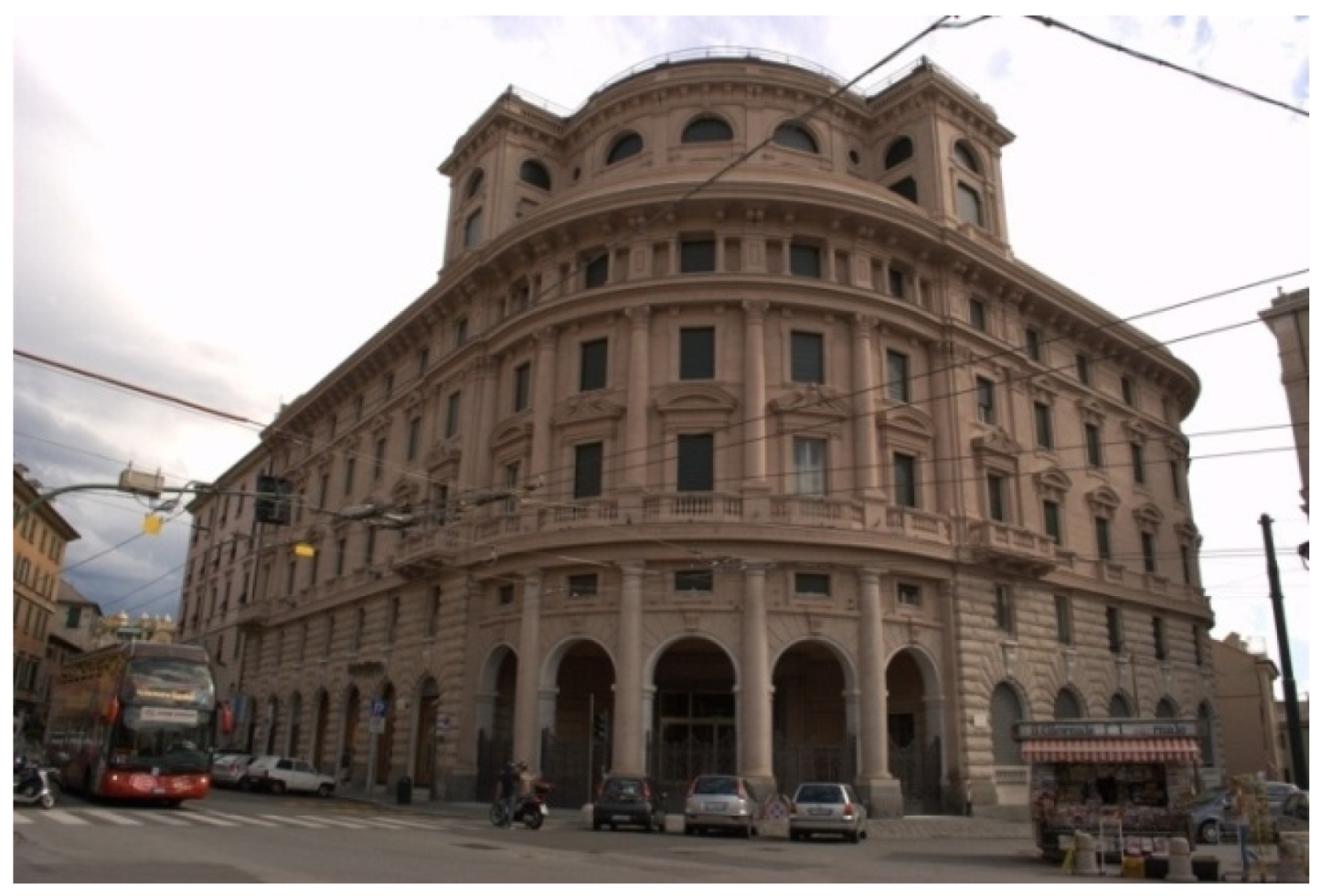
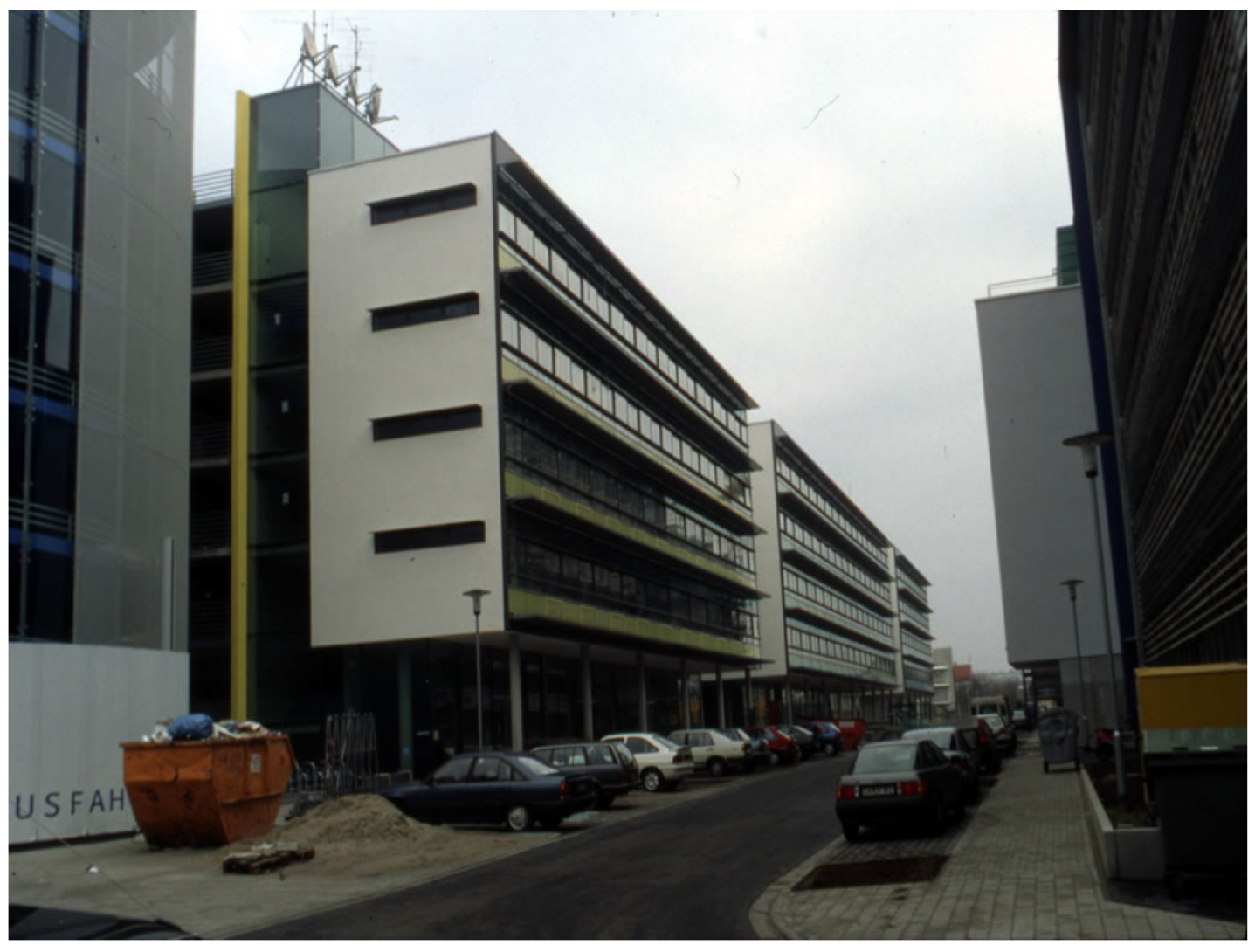
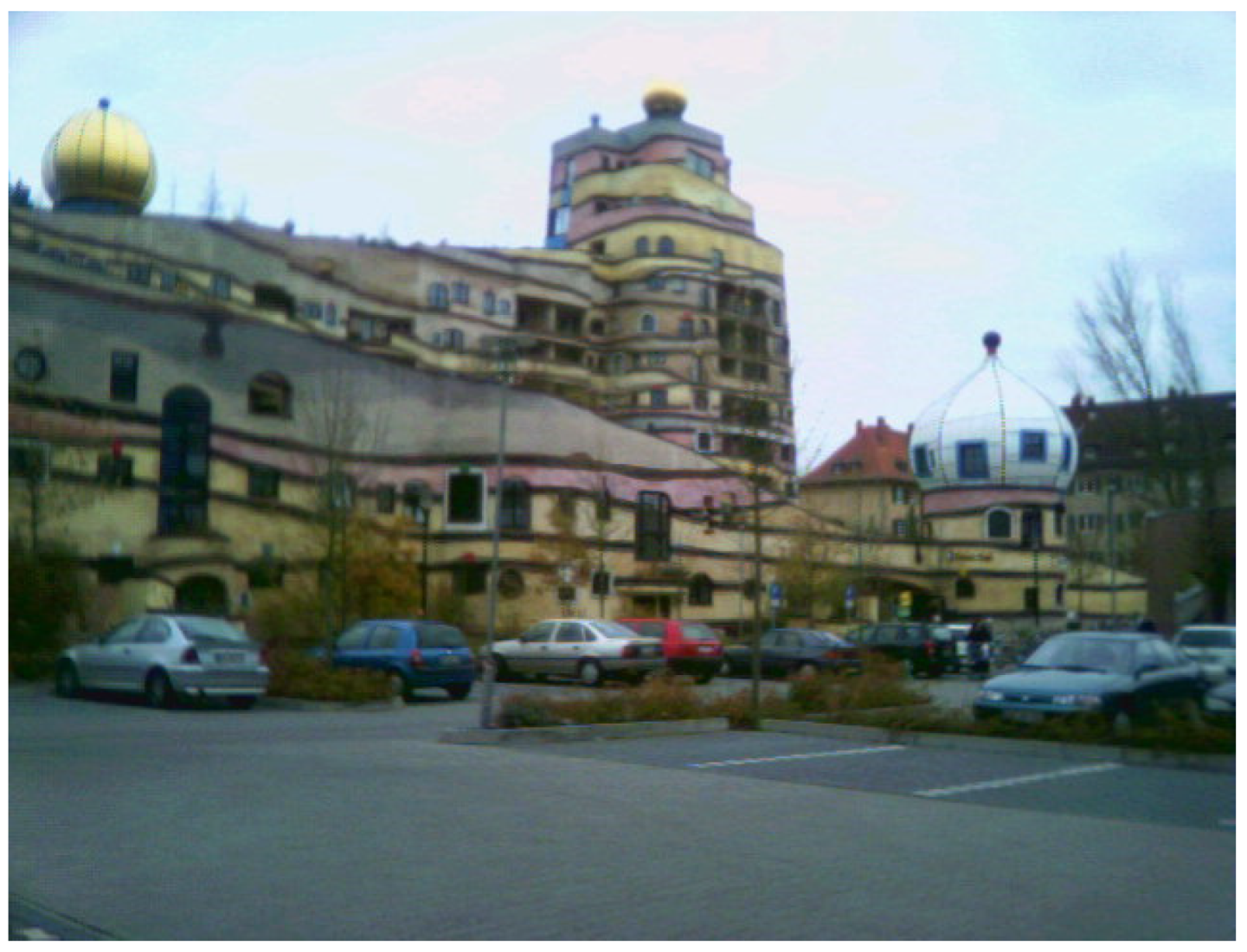
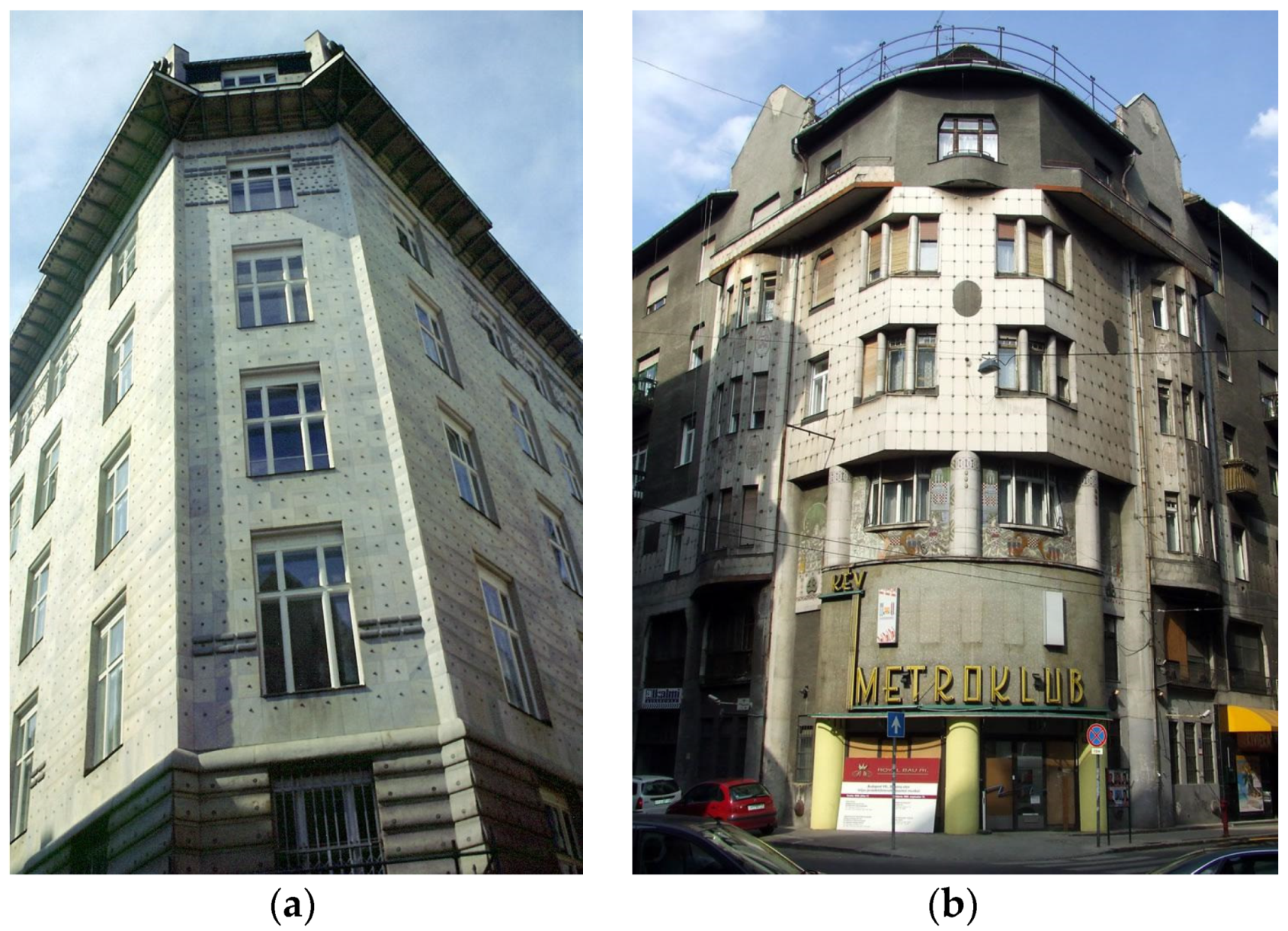
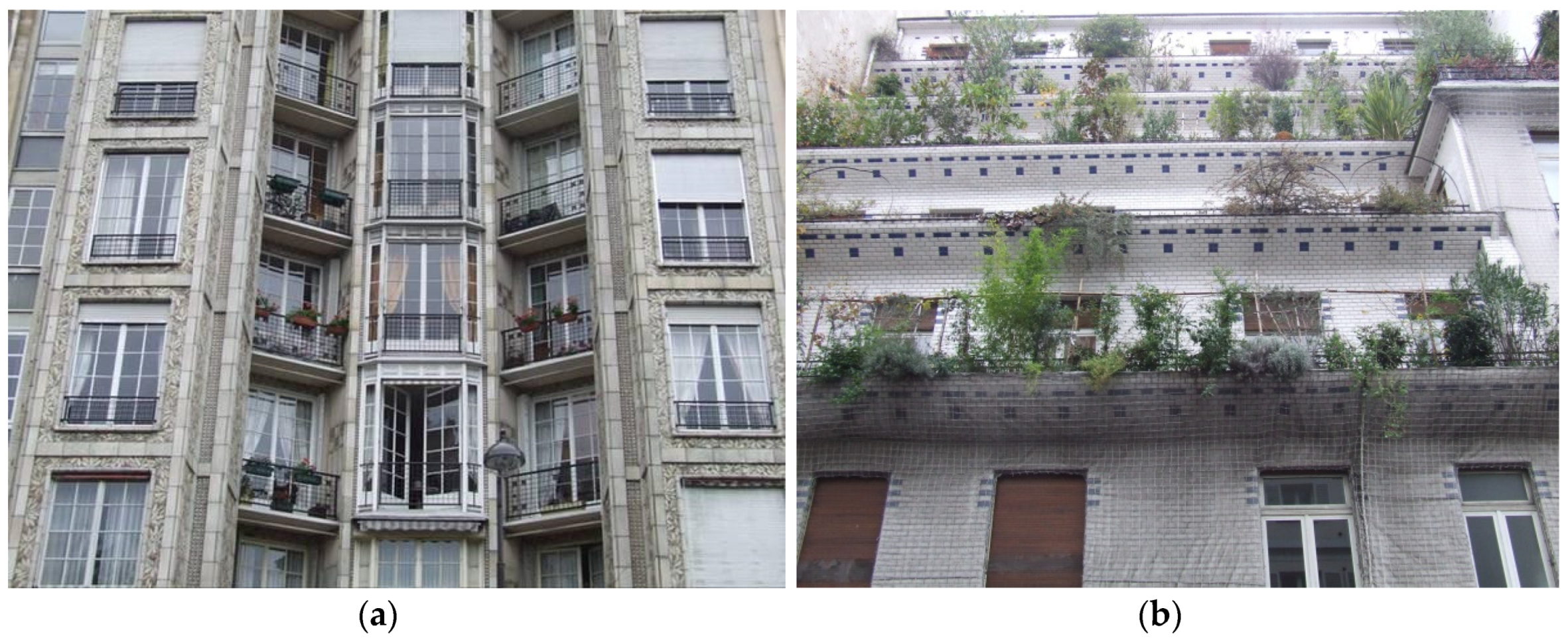
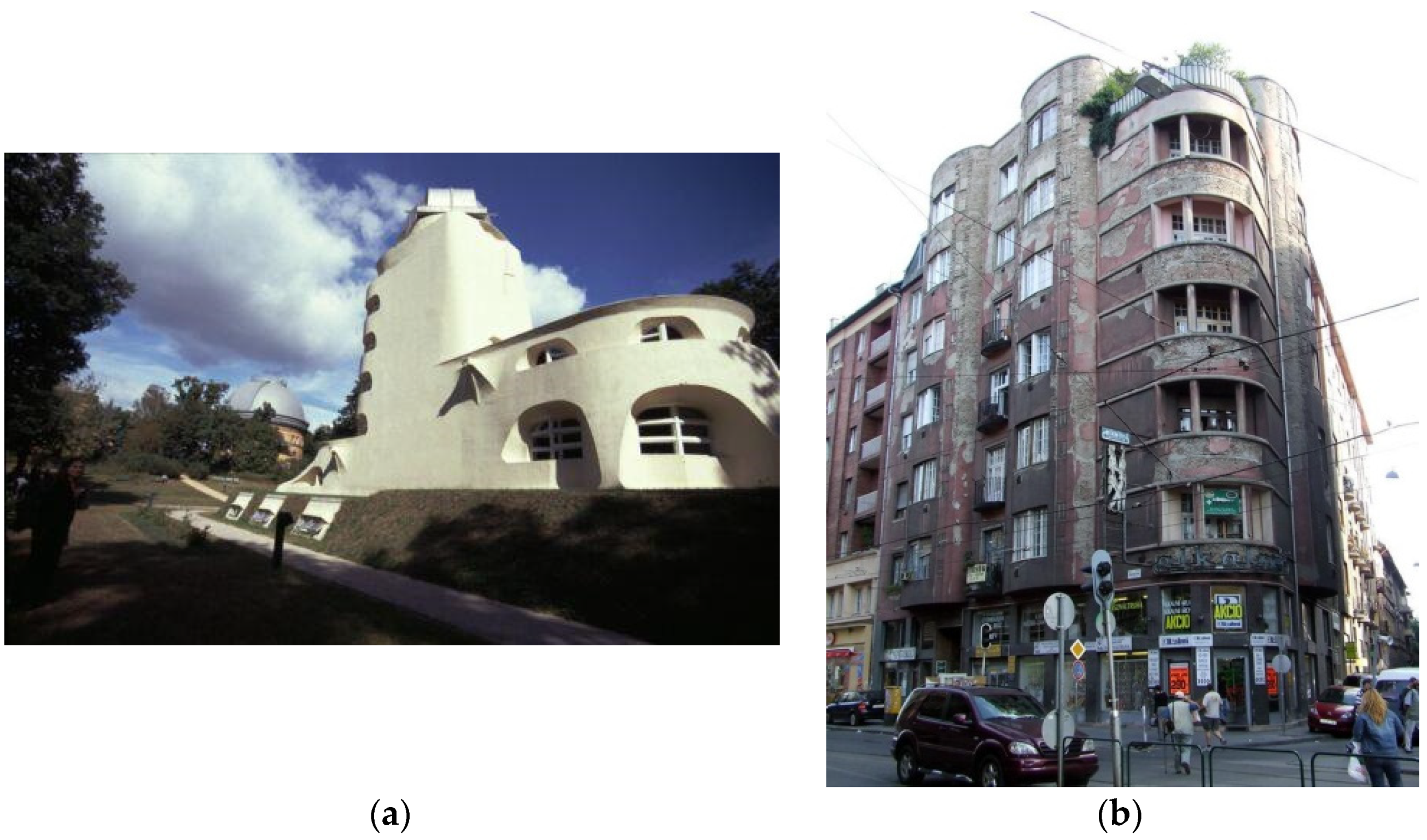
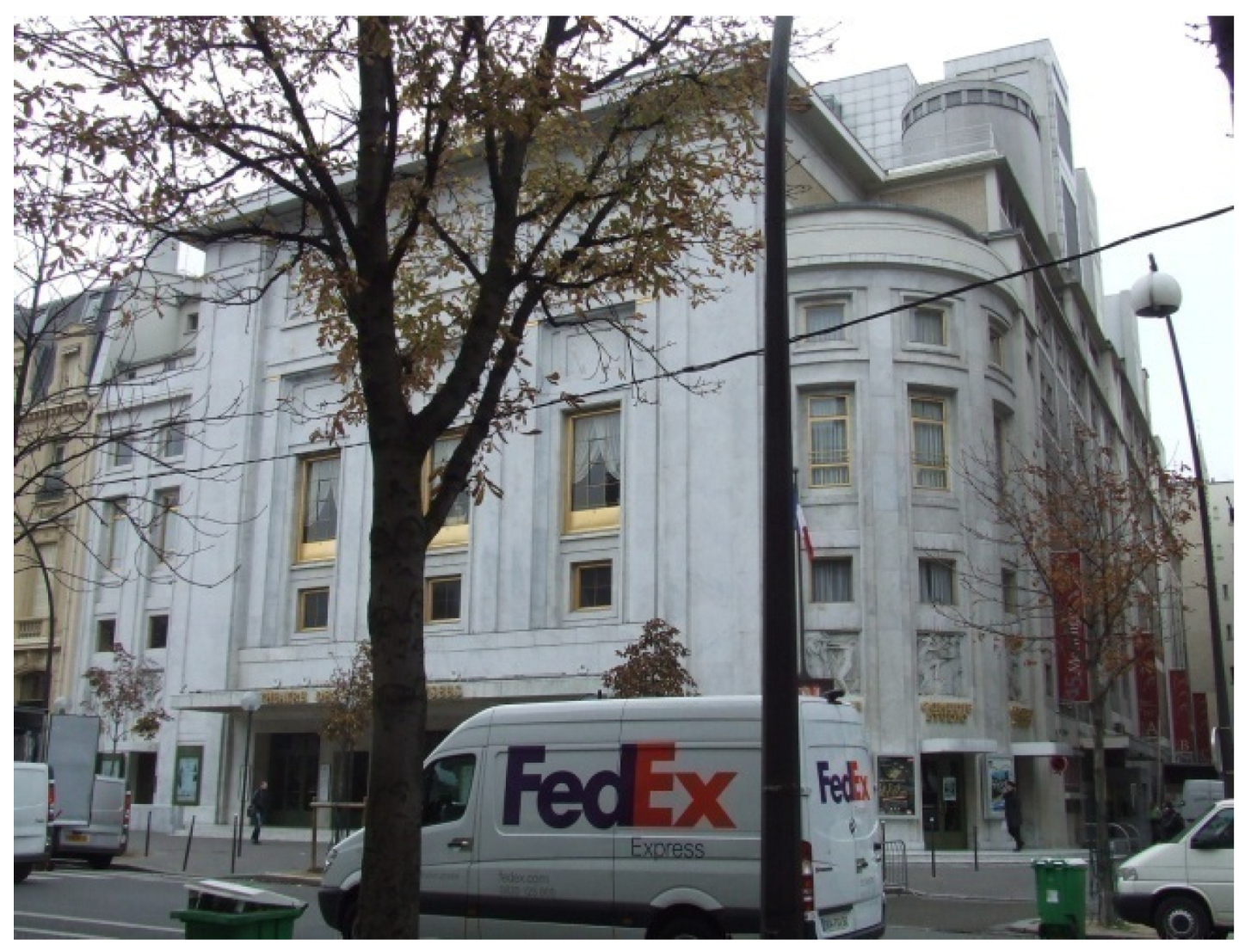
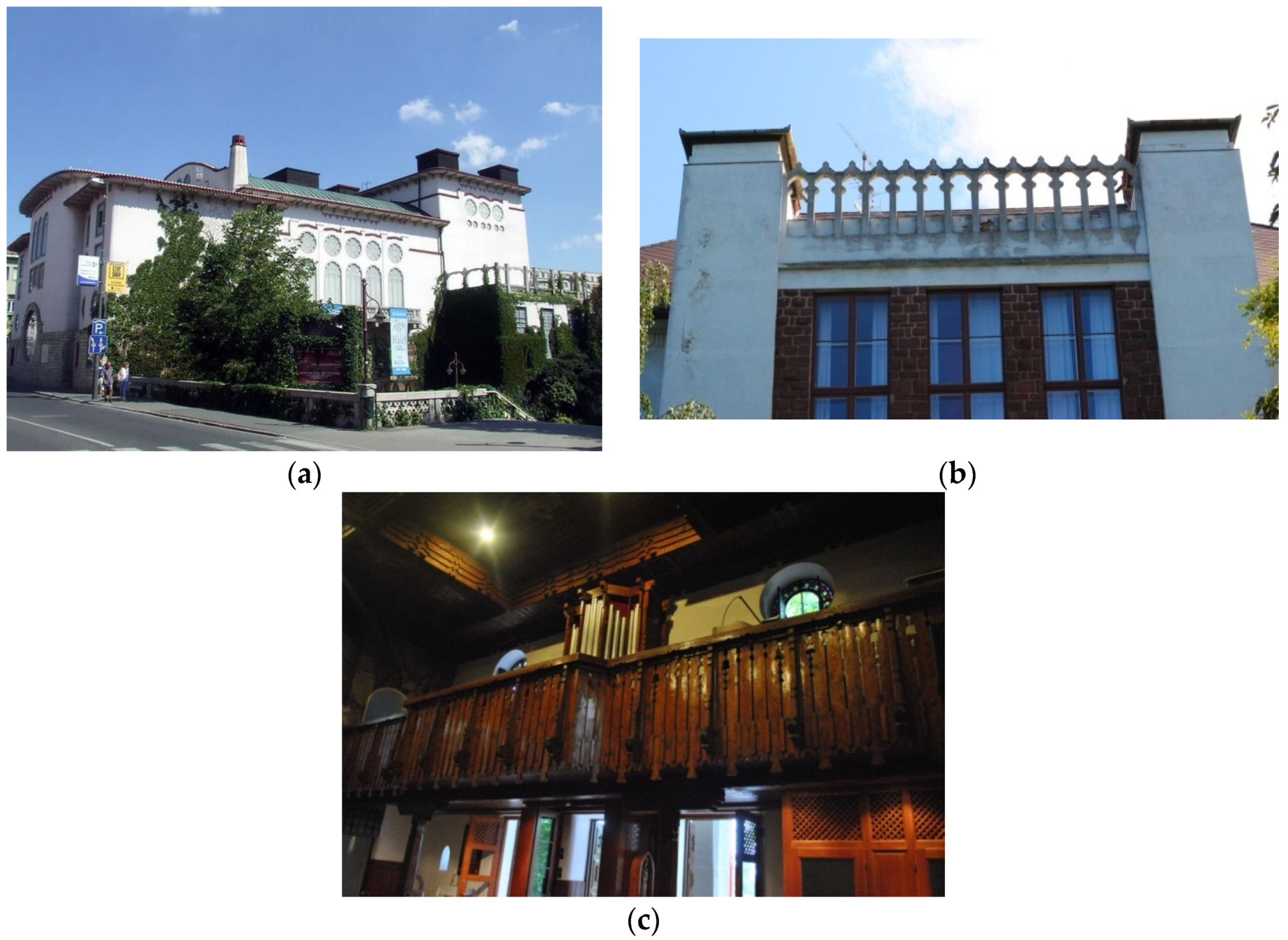
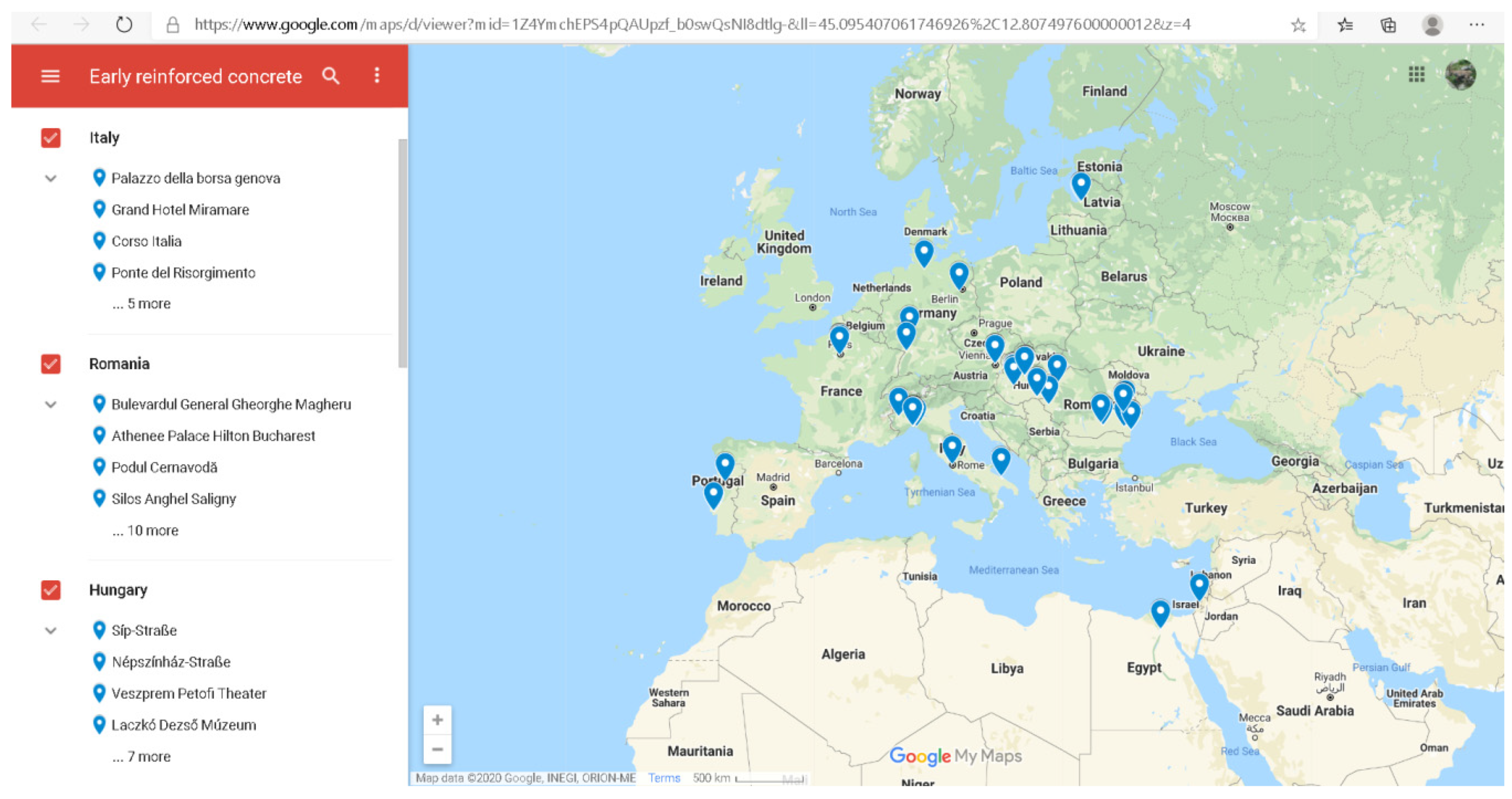
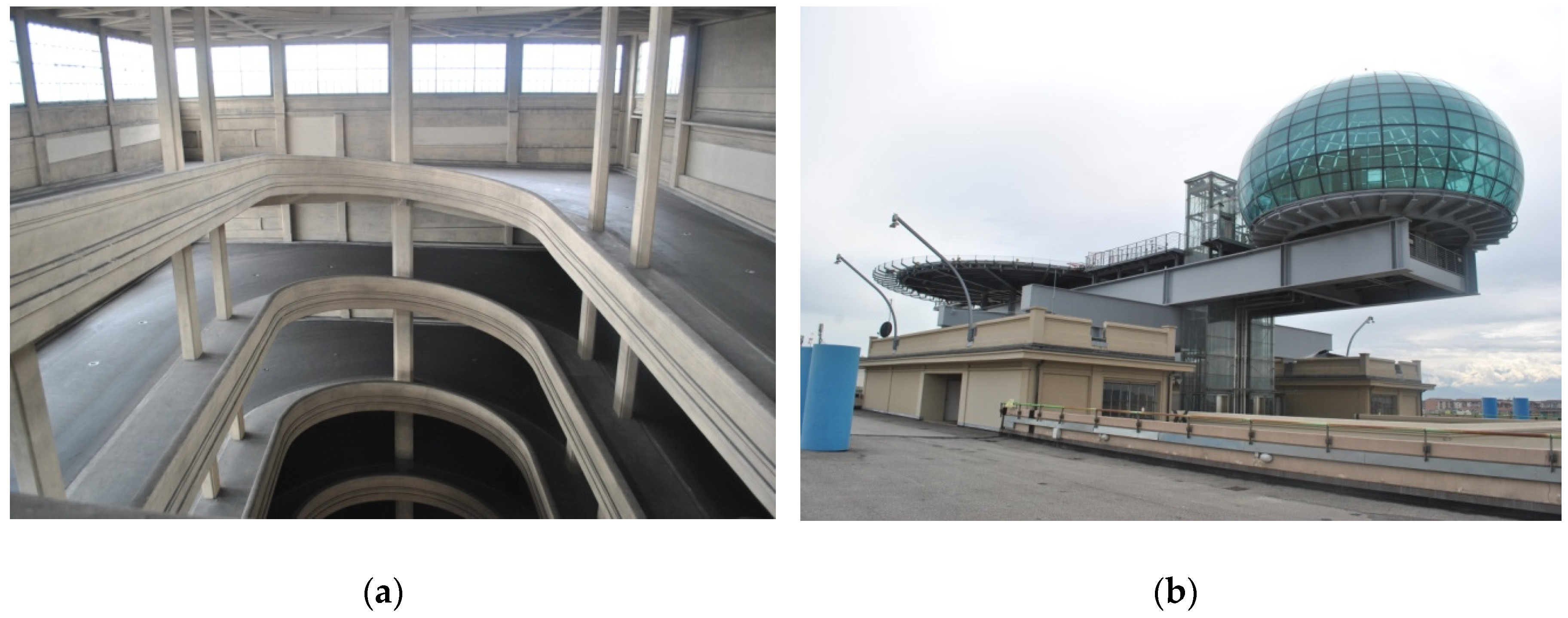
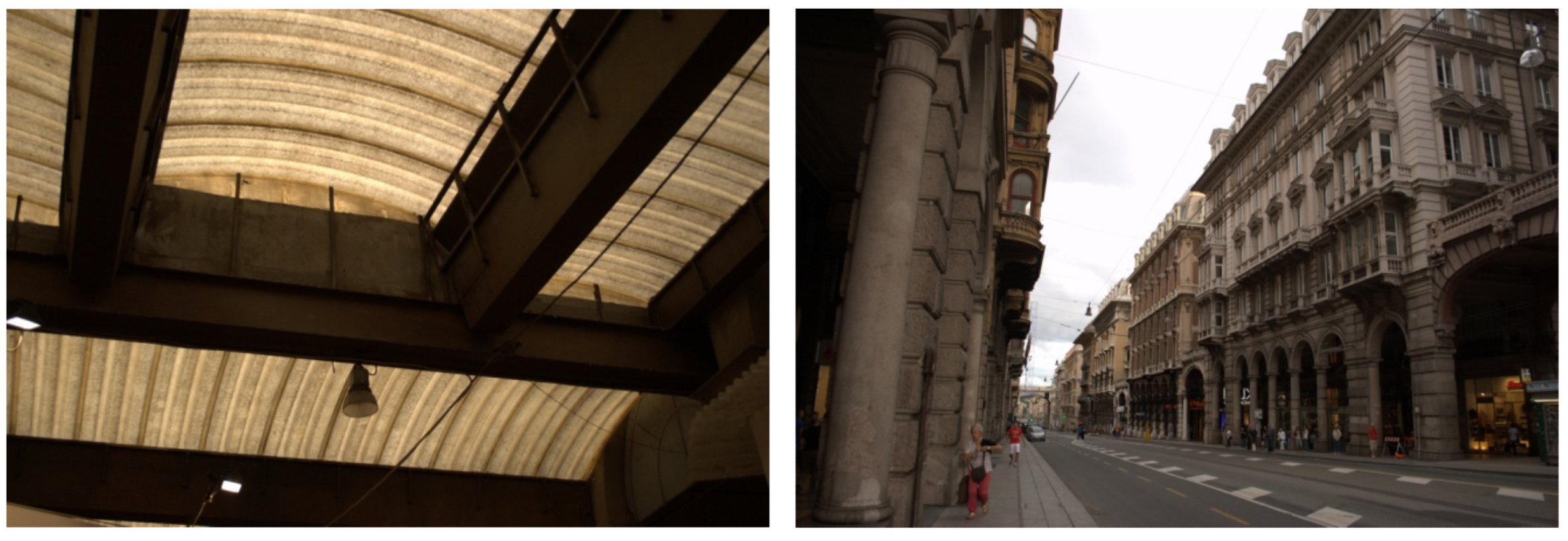
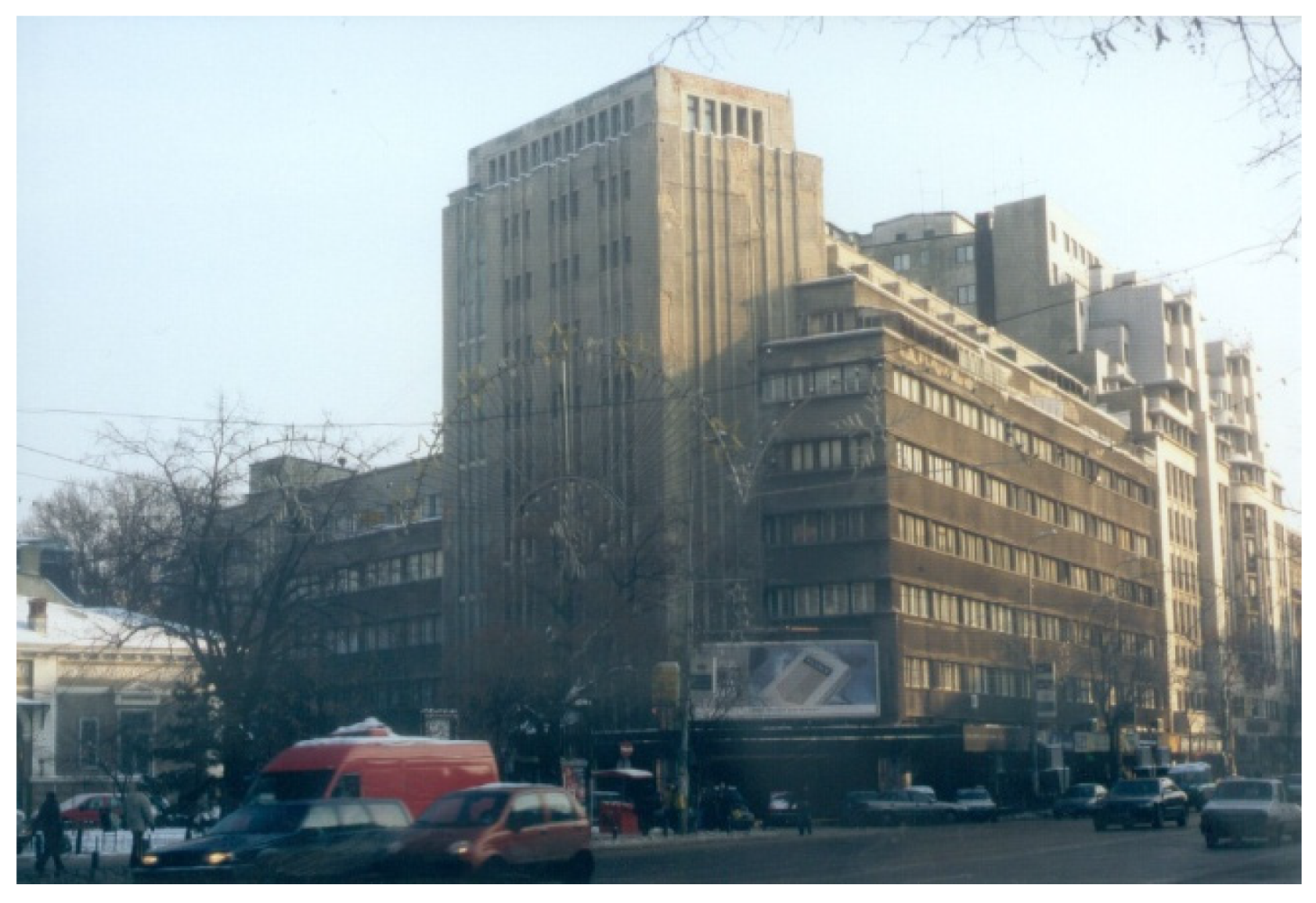
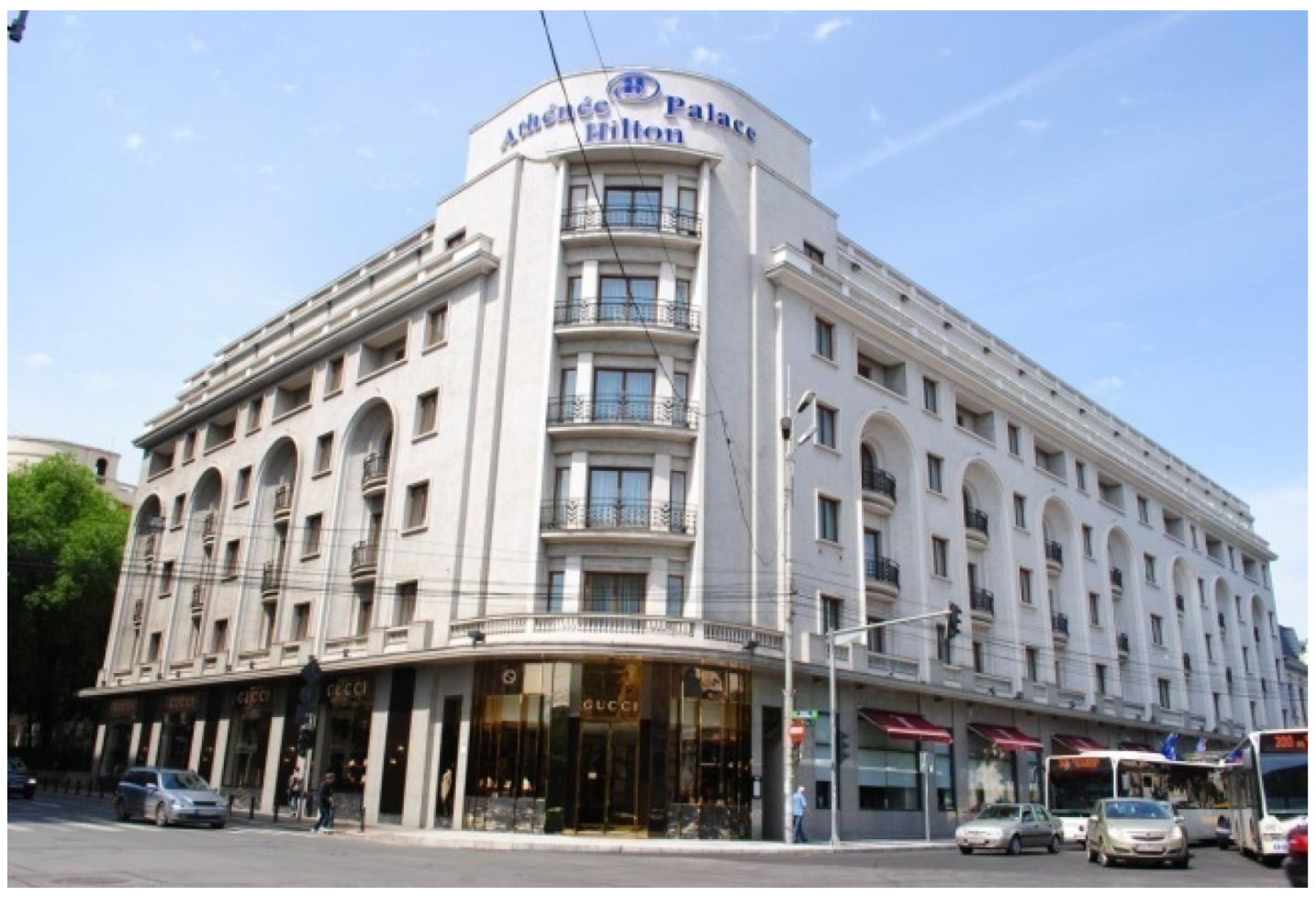
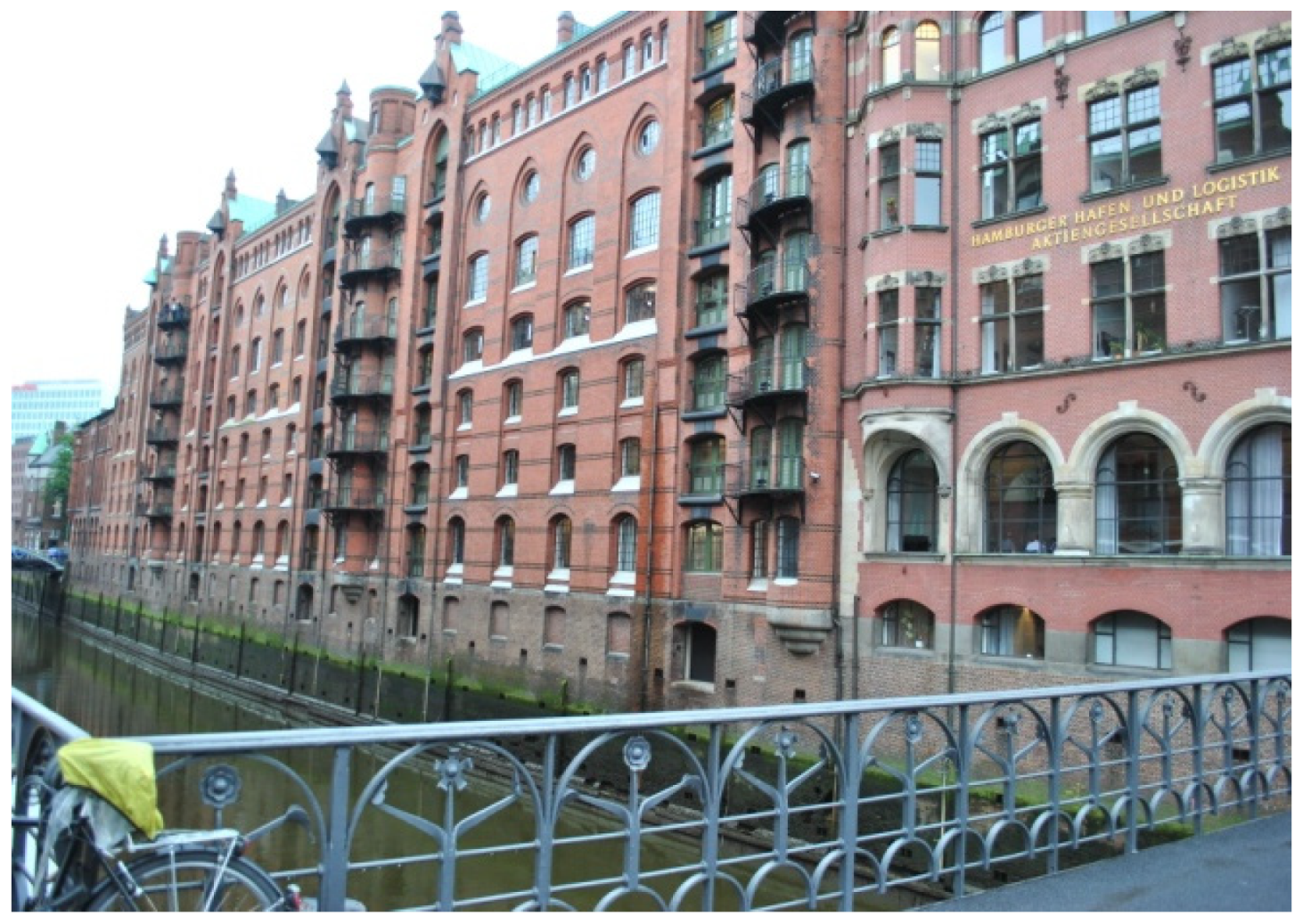
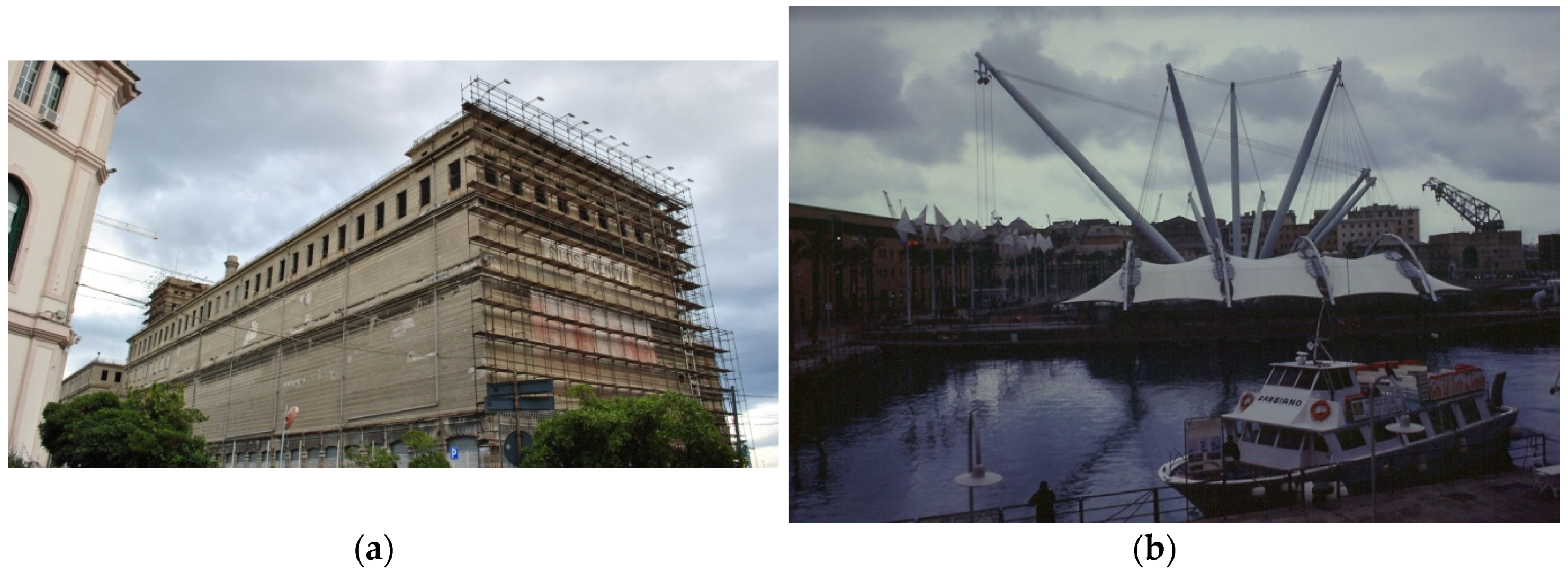
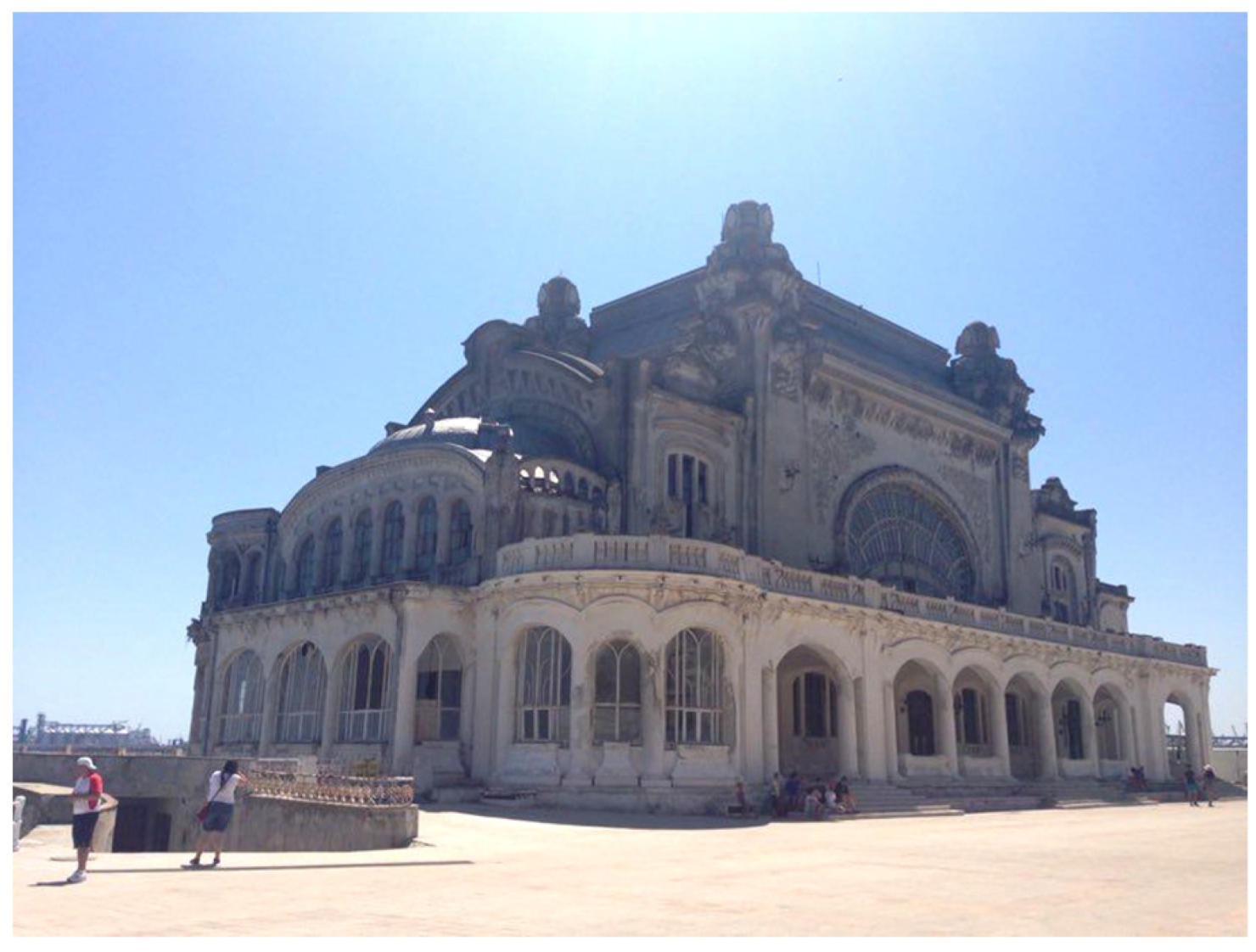
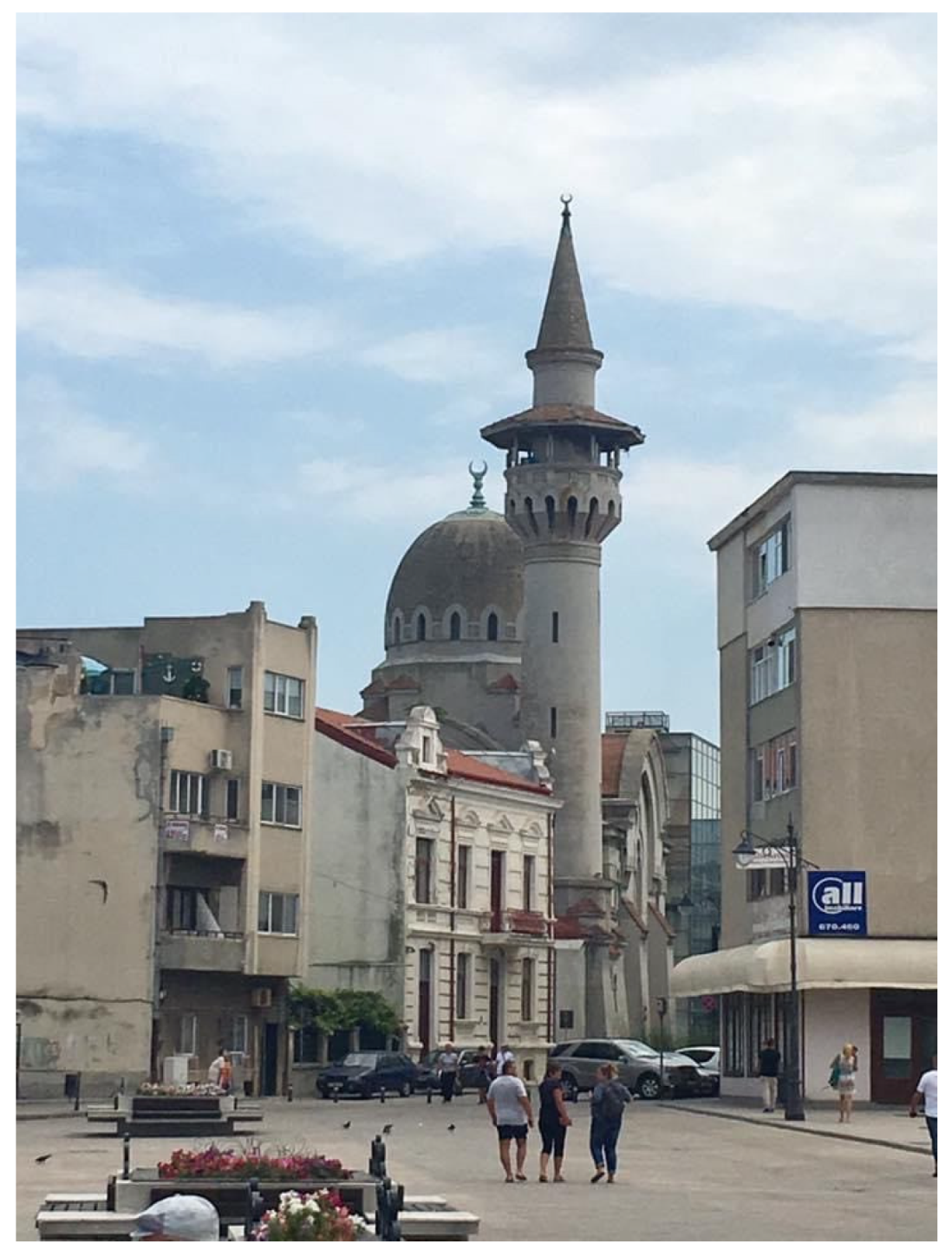
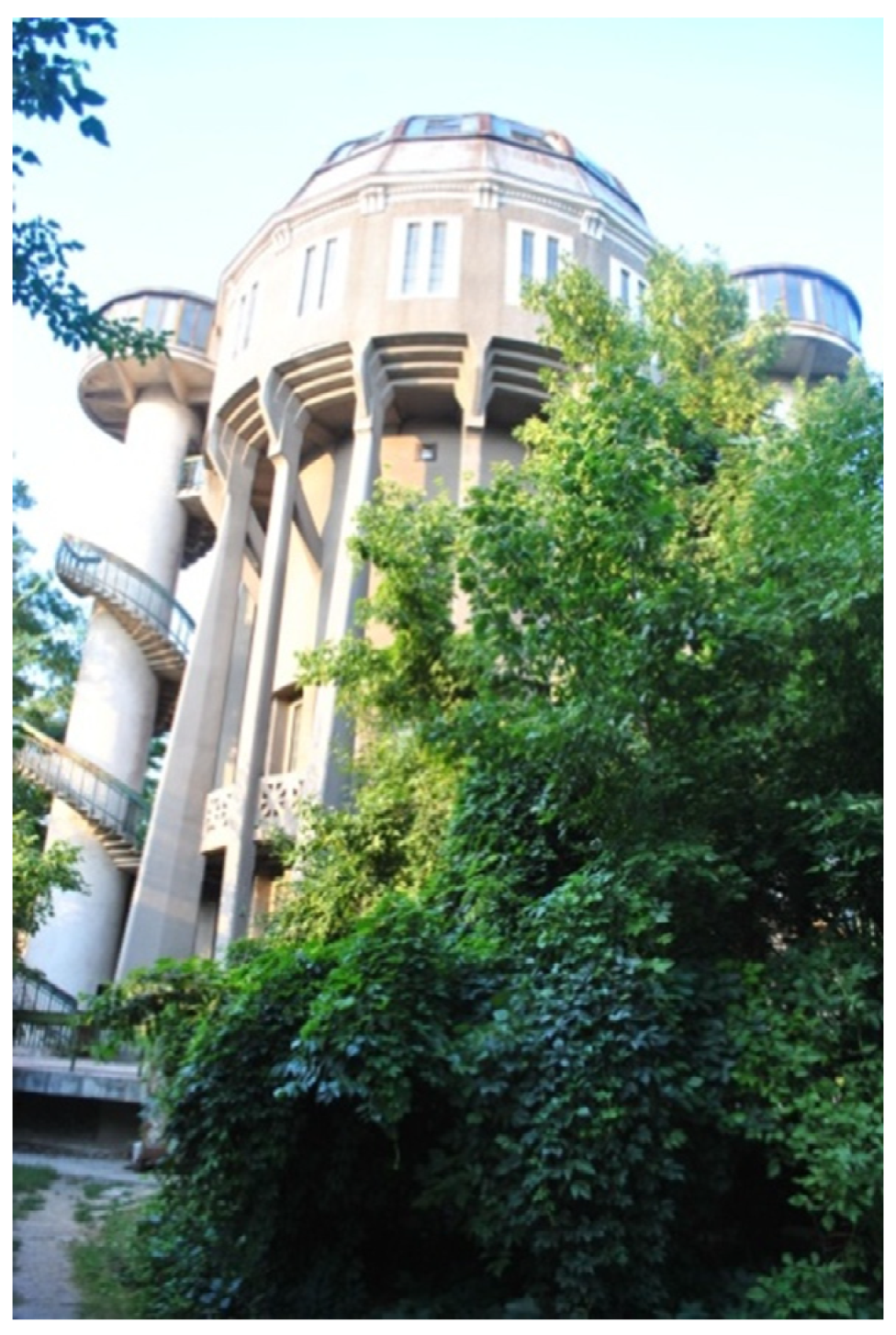
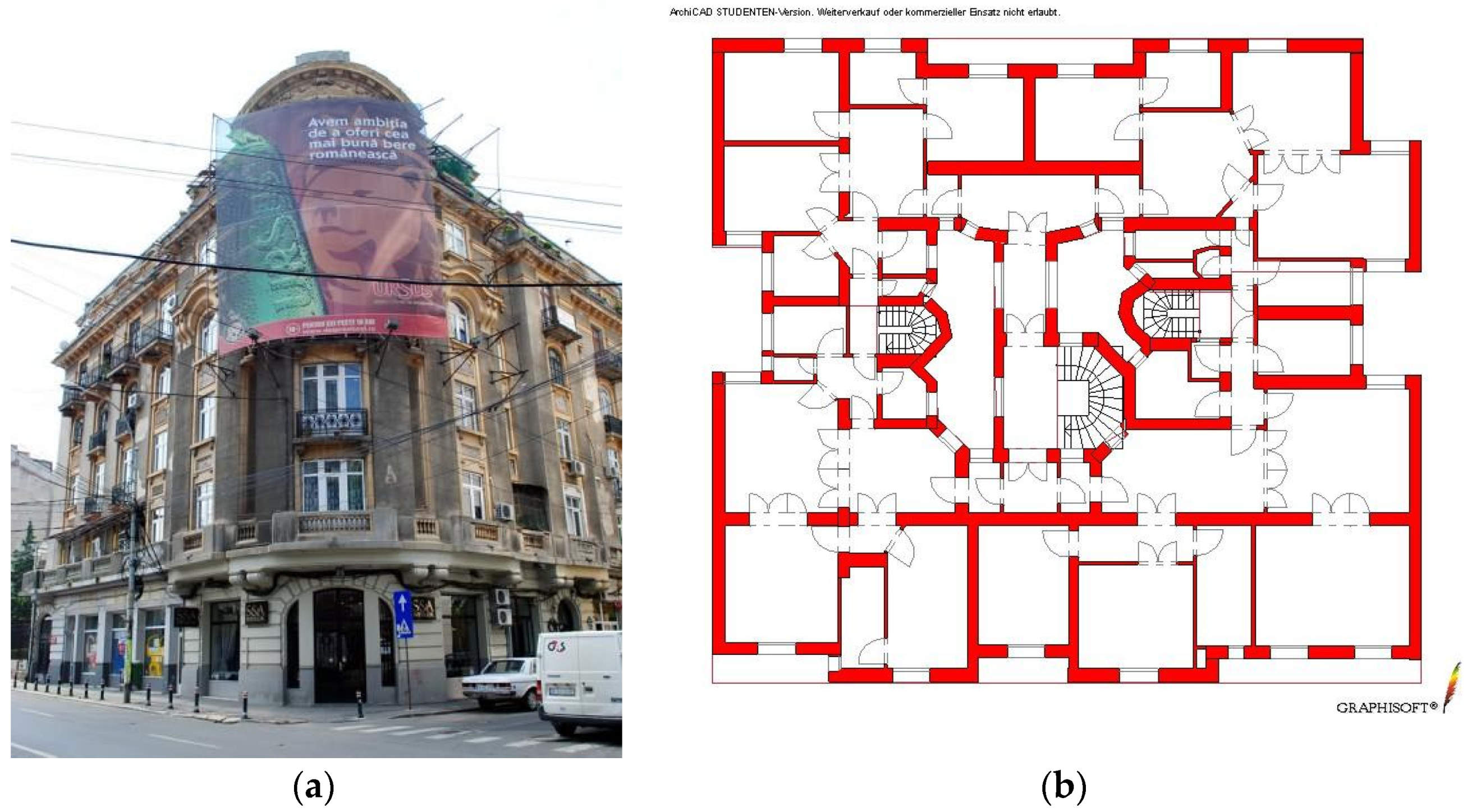
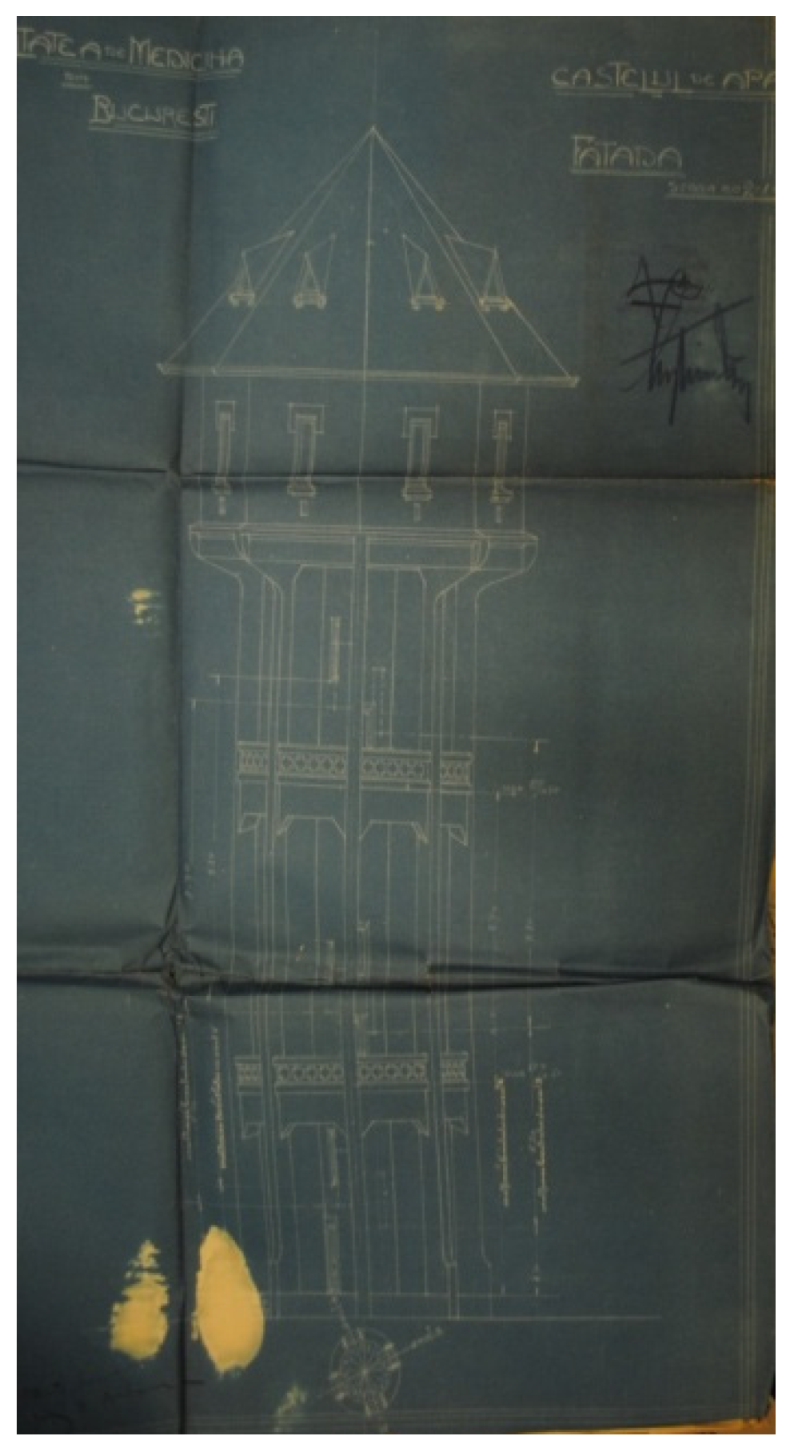
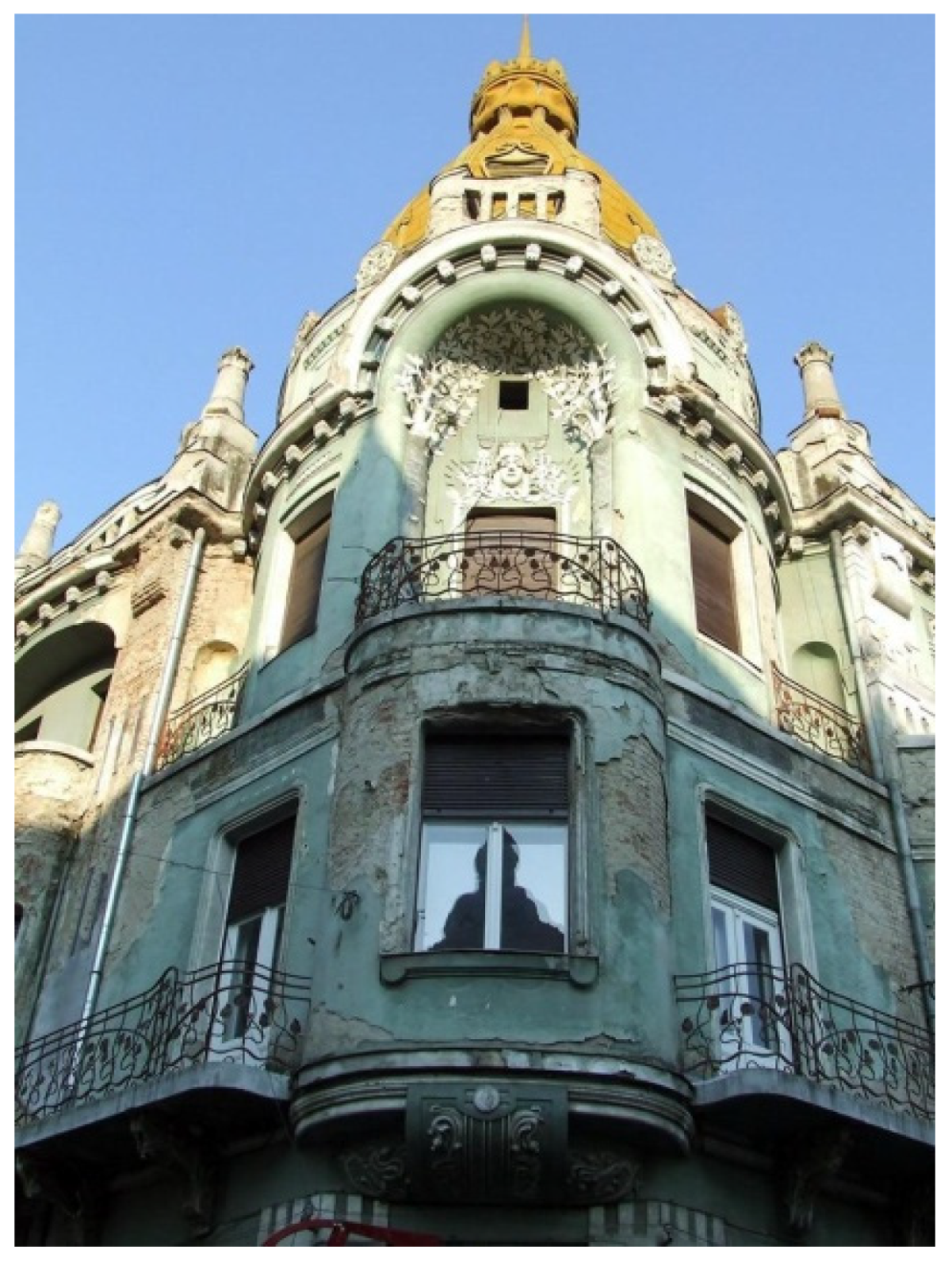
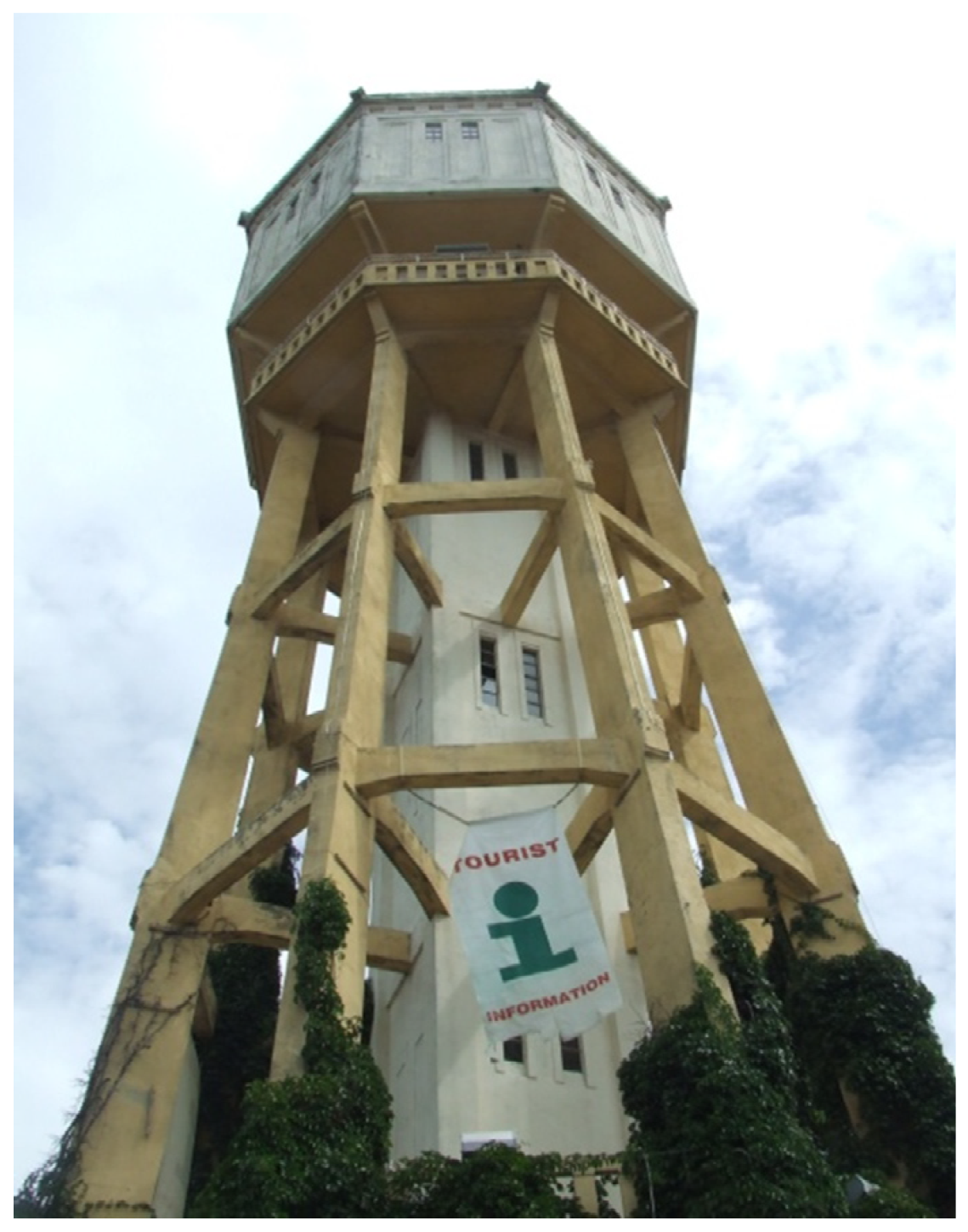
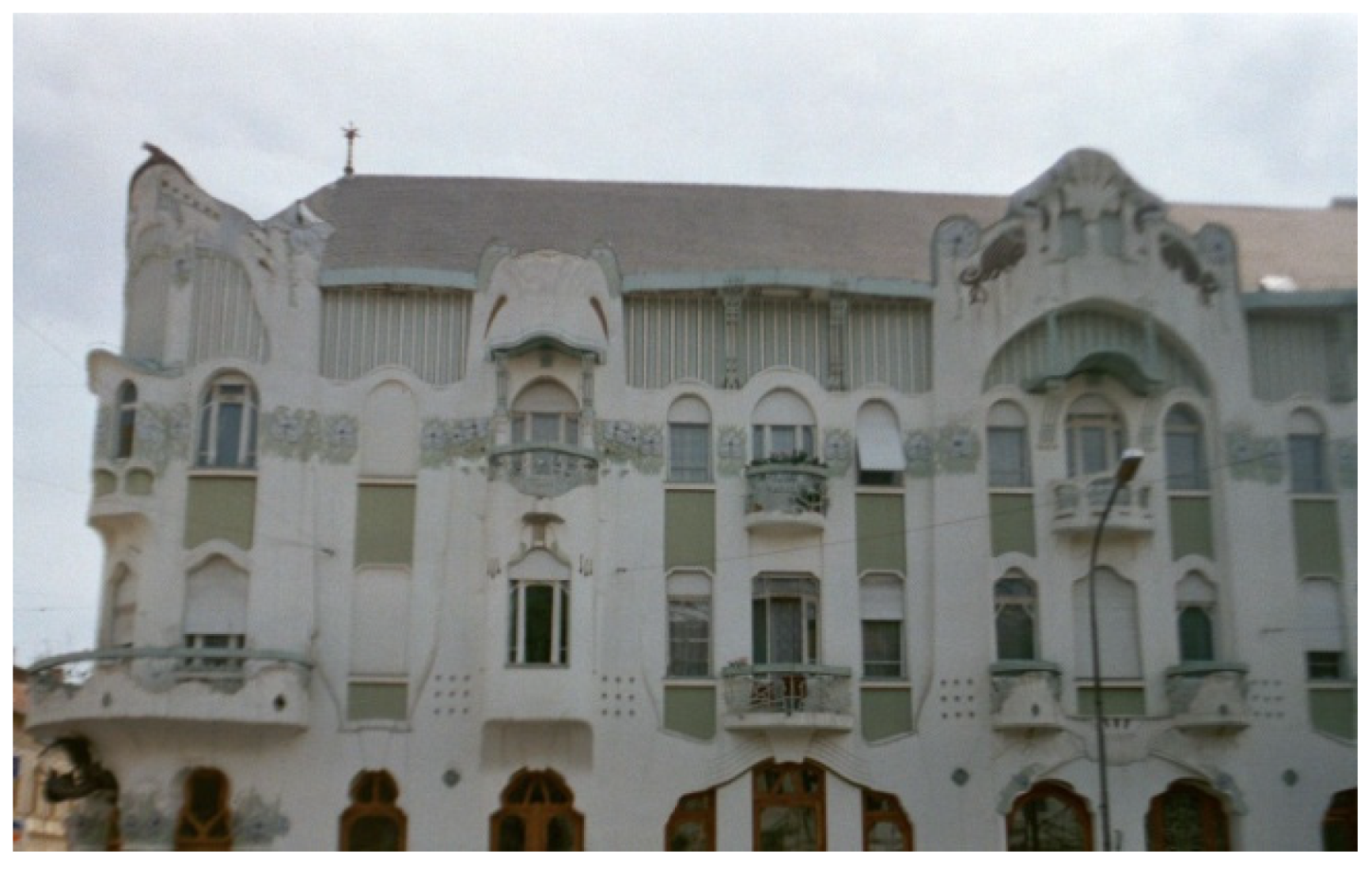
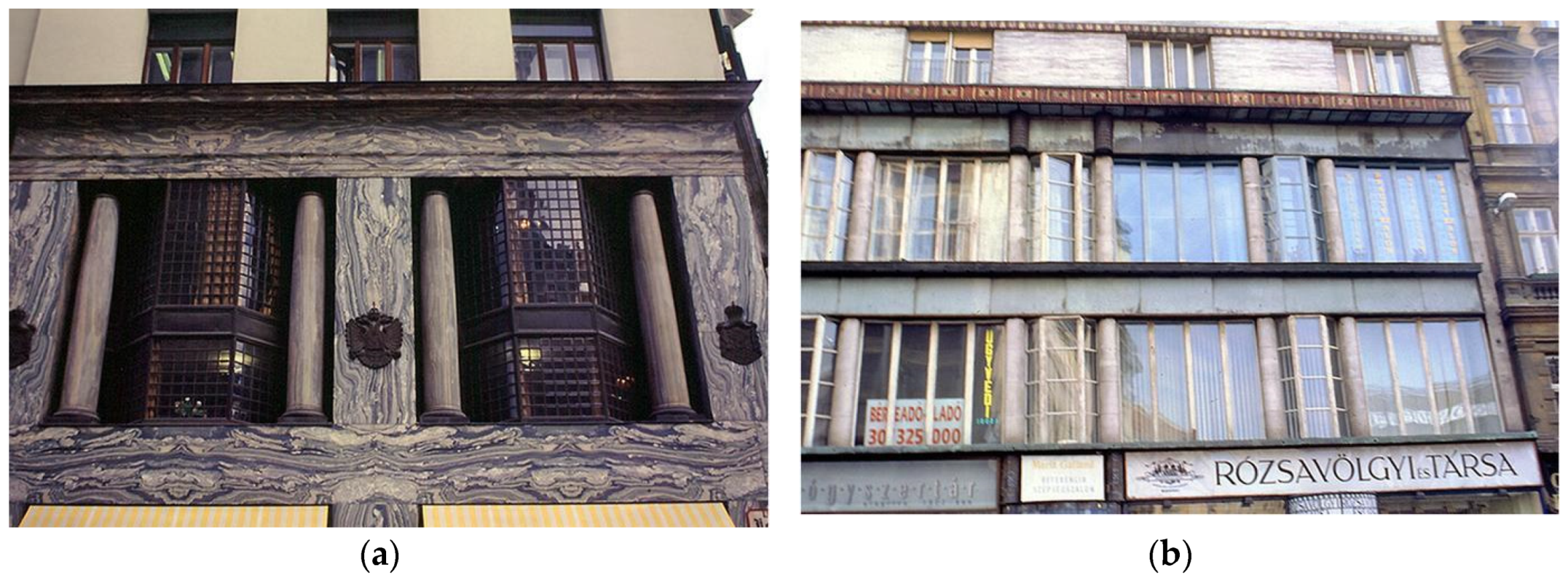
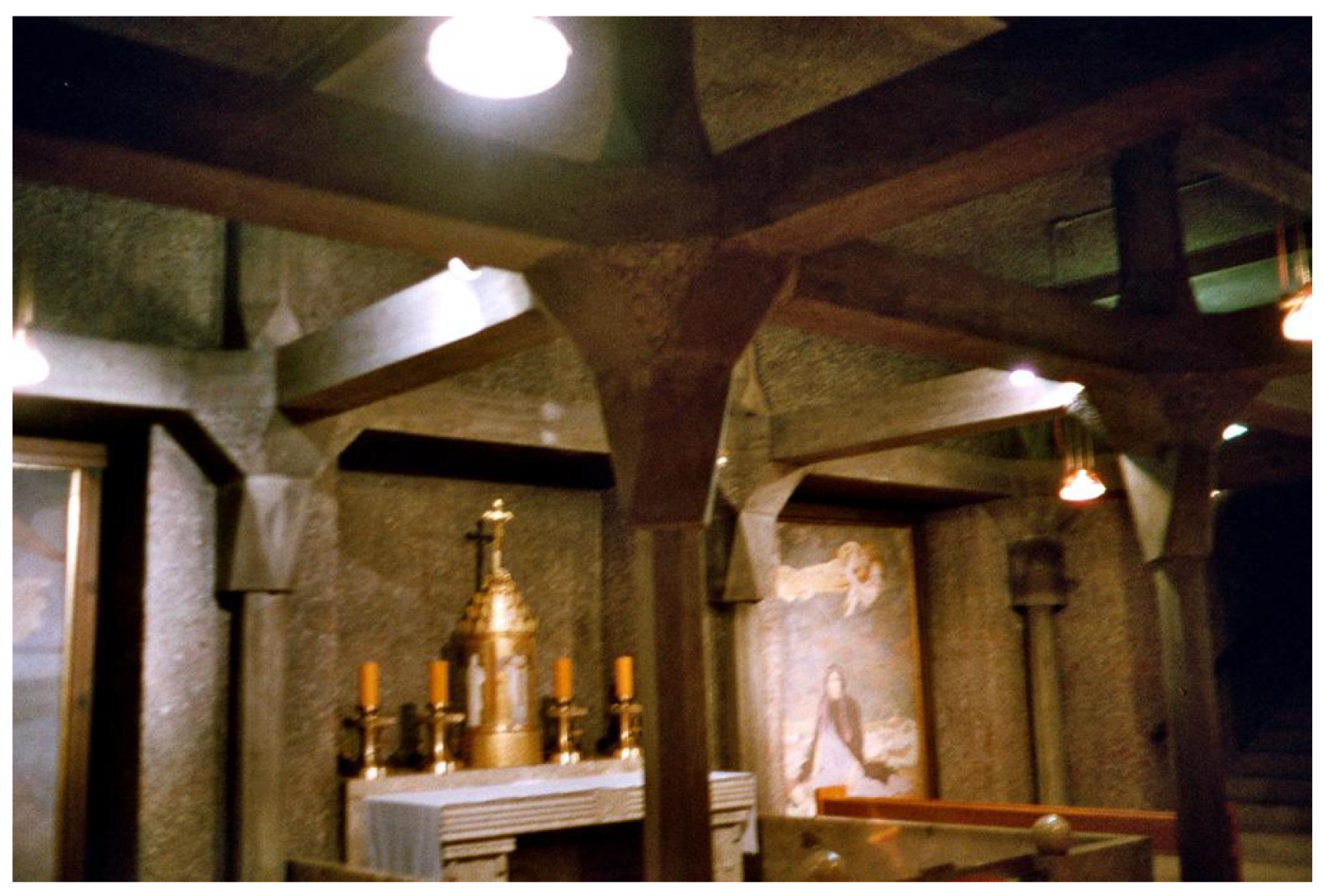
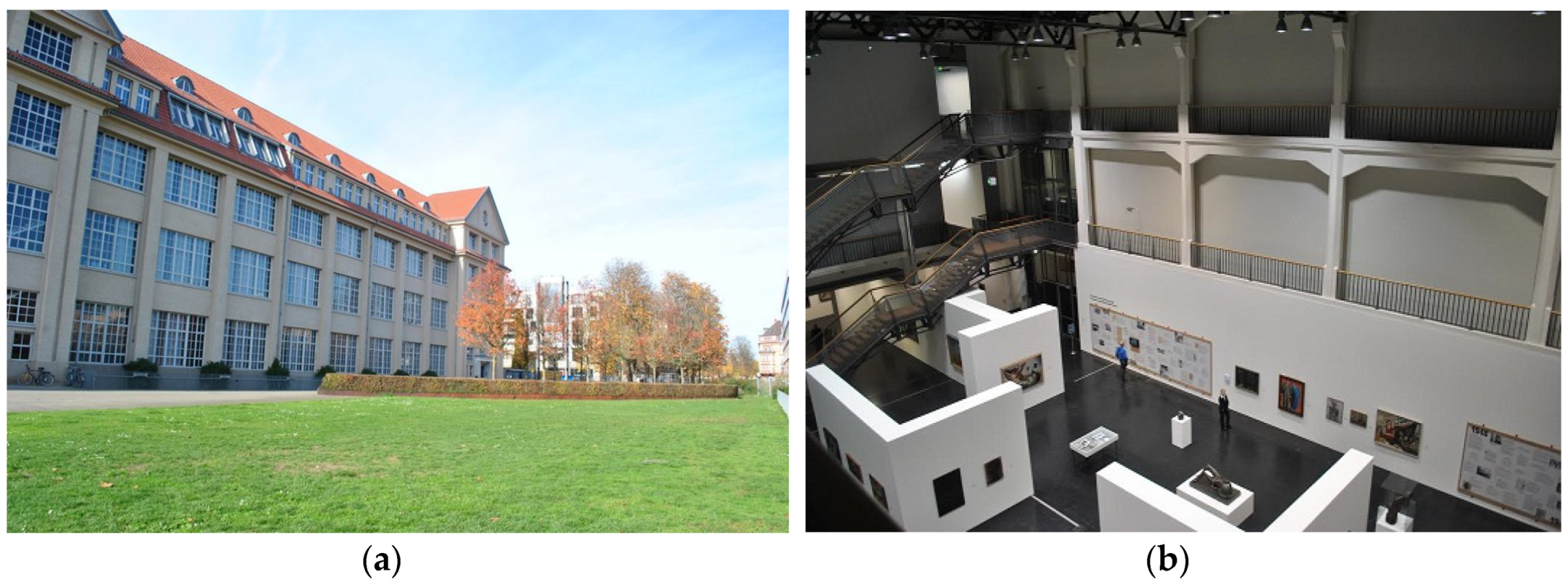
| Country | Name of Work | City | Intervention |
|---|---|---|---|
| Italy | Palazzo della Borsa | Genoa | Restored |
| Grand Hotel Miramare | Genoa | Restored | |
| Porto Antico | Genoa | Restored + extension | |
| Via XX Settembre | Genoa | Preserved as is | |
| Mercato Orientale | Genoa | Preserved as is | |
| Silos | Genoa | Call for tender | |
| Ponte del Risorgimento | Rome | Preserved as is | |
| Lingotto | Torino | Restored + extension | |
| Ponte Corso Italia | Bari | Need for restoration | |
| Romania | Bulevardul Magheru | Bucharest | Red dot policy calling for restoration |
| Athenée Palace | Bucharest | Transformed more times | |
| Block of flats on Frumoasă street | Bucharest | Preserved as is | |
| Water tower at Medicine faculty | Bucharest | Demolished | |
| Water tower on Știrbey domain | Buftea near Bucharest | Preserved as is | |
| Cernavodă Bridge | Cernavodă | Closed | |
| Silos | Constanța | Different suggestions for restoration | |
| Casino | Constanța | Call for tender | |
| Mosque Carol I | Constanța | Preserved as is | |
| Silos | Galați | Preserved as are | |
| Silos | Brăila | Preserved as are | |
| Water tower | Brăila | Restored | |
| Moskovits Miksa Palace | Oradea | Restored | |
| Water tower at CFR locomotive depot | Timișoara | Neglected, unlike other ones in the same city | |
| Hungary | Arkaden-Basar | Budapest | Restored |
| Building on Népszinház street | Budapest | Neglected | |
| Rózsavölgyi house | Budapest | Preserved as is | |
| Water tower on Margaret island | Budapest | Restored | |
| Water tower on Svábhegy | Budapest | Preserved as is | |
| Petőfi theatre | Veszprém | Restored 1984–1988, functional adaptation keeping main character | |
| Laczkó Dezső museum | Veszprém | Restored in the 1980s | |
| Szent Imre church | Balatonalmádi | Preserved as is | |
| Water tower | Siófok | Restored | |
| Reők palace | Szeged | Restored | |
| Water tower | Szeged | Restored | |
| Austria | Loos house | Vienna | Preserved as is |
| Church of Holy Spirit | Vienna | Preserved as is | |
| Postsparkasse | Vienna | Restored | |
| Portugal | Luis Bandeira Bridge | Rio Vouga | Submerged to a dam |
| Water tower | Barreiro | Call for tender | |
| Water tower, Penha de Franca | Lisbon | Preserved as is | |
| Faculty of Medicine, University of Lisbon | Lisbon | Preserved as is | |
| Latvia | Water tower of Agenskalns | Riga | Preserved as is |
| Water tower Čiekurkalns | Riga | Preserved as is | |
| Germany | Bürgerparkviertel | Darmstadt | New development in historic site |
| Einsteinturm | Potsdam | Restored | |
| ZKM | Karlsruhe | Restored + extension | |
| Speicher Altona | Hamburg | Restored + extension | |
| Egypt | Baron Palace | Cairo | Subject of investigation from Vienna |
| Israel | Water tower | Tel Aviv | Restored |
| France | Block of flats Rue Franklin | Paris | Preserved as is |
| Théâtre des Champs-Élysées | Paris | Restored | |
| Block of flats Rue Vavin | Paris | Restored | |
| Villa Hennebique | Bourg-la-Reine near Paris | Altered in time |
© 2020 by the author. Licensee MDPI, Basel, Switzerland. This article is an open access article distributed under the terms and conditions of the Creative Commons Attribution (CC BY) license (http://creativecommons.org/licenses/by/4.0/).
Share and Cite
Bostenaru Dan, M. Building the Future on Lessons of Historic Reinforced Concrete. Sustainability 2020, 12, 5925. https://doi.org/10.3390/su12155925
Bostenaru Dan M. Building the Future on Lessons of Historic Reinforced Concrete. Sustainability. 2020; 12(15):5925. https://doi.org/10.3390/su12155925
Chicago/Turabian StyleBostenaru Dan, Maria. 2020. "Building the Future on Lessons of Historic Reinforced Concrete" Sustainability 12, no. 15: 5925. https://doi.org/10.3390/su12155925
APA StyleBostenaru Dan, M. (2020). Building the Future on Lessons of Historic Reinforced Concrete. Sustainability, 12(15), 5925. https://doi.org/10.3390/su12155925





